
MAGIC's Craig
-
Posts
58 -
Joined
-
Last visited
Content Type
Profiles
Forums
Gallery
Events
Posts posted by MAGIC's Craig
-
-
Before skinning the boat with a fine-weave fiberglass cloth set in epoxy, there were a few details to be completed. The first was to drill the hole for the rudder post. This rudder post is perpendicular to the DWL and after some careful measurements and a check for prop clearance, I used an awl to dimple where the hole should emerge from the hull. Once again, we leveled the building board and set up the laser level on a stepladder (and blocks) perpendicular to the boat's centerline with the projected horizontal line at the DWL and the light of the vertical line "emerging" from the hull on the centerline of the rudder post. Vicky called out whether I was plumb fore and aft while I sighted along the boats fore and aft centerline marked on the bottom of the keel. The technique worked well.
Because the hull is rising toward the knuckle (when right side up), a wooden bung was cut out with a plug cutter and, before being removed from the stock, a centered hole was drilled in it to permit the rudder post's upper bearing to sit square with the rudder post. The "holed" plug (or boss) was slid down the drill bit representing the rudder post until it contacted the hull and scribed to accommodate the angle of the hull at that location.
The boss was glued in place and the drill retracted.
While we had the laser set up, I took the opportunity to put tick marks along the line of light representing the DWL. While I know where it should be from the drawings, it is always a bit of a treat to see it in 3 dimensions.
The next phase is to seal the hull with the epoxy and fiberglass cloth sheathing. After doing this with MAGIC, I realized that this would be easier for me to do one side at a time. I attached some planks to the side of the building board to permit the whole structure to lay on its side. Once clamped to the trestles, the cloth wa smoothed on dry and then wet down with the epoxy.
Once both sides were initially sheathed, the building board was returned to its usual position and additional smoothing coats of epoxy and sanding filler were applied, scraped down and sanded
I will pick up the rudder construction next.
-
Thanks to you all for the support and appreciation. I will post again tomorrow.
- Keith Black, mtaylor, lmagna and 1 other
-
 4
4
-
The broad strakes were fairly straightforward to cut and fit, though they were offered up multiple times each to permit making tight fits to the previous plank.
.
Once the planking sequence had moved beyond the curve of the forefoot, the landing for the keel was planed flat athwartships and a suitable thickness of stock was offered up to be scribed to the needed shape. Here it is clamped in place to lay out the location for a stepped scarf to be cut for connection to the stem.
The next photo is actually posted upside down but it permits viewing the structure in the aft end of the hull (as well as a lot of drip-and-squeeze-out to be cleaned up). The small "box" under the deck aft holds the rudder servo. I had meant to simply build the box into the stern prior to fitting the final piece of blocking and then remove the servo to keep it out of harm's way. However, I made it too tight of a fit and the servo remains in place.
The planking continued to be fitted working toward the stern's "knuckle" and the keel was tapered and glued in place. The design of the hull incorporating the"knuckle" was a suggestion of Bill Garden's for allowing some width to the deck level aft while letting the run easily release the water's flow without dragging a transom. The "knuckle" blends into the rounded bilge as it goes forward by about station #6.
And as the plank strakes "turned the corner", this became clearer after the first topside plank went into place.
By April 25th, the rest of the planks to the level of the deck edge were in place and the stem had been bonded in place. Final fairing of the upper edge of the stern "block" awaits the turn-over of the hull as will the bulwark planking.
-
While I planned to sheath the hull with an epoxy/'glass layer for strength and watertightness, I wanted to try a proper planking technique as discussed on the "Modeling Techniques" portion of this site for practice. My drafting board drawer still had some rolls of 1/8" wide drafting tapes, so I utilized them to help define the bands of planking which would be necessary.
The tapes certainly assisted eyeballing fair curves around this 3 dimensional curvilinear shape. Once the locations seemed suitable, as recommended I divided the space within the bands at each frame into equal widths and marked that frame. To transfer the plank width markings to the other side of the hull. I overlayed a clear plastic strip on the marked frame, put dots on the plastic and then shifted the strip to the same frame on the other side. An awl was used to punch through the strip at the appropriate points. The divots were then highlighted with a pen.
The inboard edges of garboards would initially meet at the centerline "above" the keelson, so these planks were made about 2-1/2 times wider than the "standard" planks. The keel would sit on a flat formed by planing the garboards back from the centerline 1/2 the width of the keel, which would visually return the garboards to a more normal double width. The two runs of broads would follow at a width of about 1-1/2 times standard plank widths before the rest of the planking was to follow.
The transition of the rabbet line aft was adjusted by gluing on thin, tapered pieces of basswood to each side of the projecting deadwood from about station 7 aft to the stern post.
By the end of March, planking began to progress (though there were the occasional mis-steps).
Offering up a piece of planking stock for scribing in as a broad strake
- ccoyle, GrandpaPhil, yvesvidal and 2 others
-
 5
5
-
The keelson tied the frames together along the centerline but additional stiffeners in the form of twin bilge stringers were glued inboard of the frames before fairing could begin. The stern "block" was rough shaped to the profile and checked with a cardboard template. Blocking was carved and fitted to the outboard locations of the forward continuation of the stern's "knuckle" on each side.
After a sternpost was glued in place, centerline wedges were added above and below the keelson to provide solid support for the shaft log.
As the fairing of the frames and keelson proceeded, I also realized that fitting in blocks to serve for the electric motor's mounting bed would be far easier to do before the garboards were fitted.
To accurately locate these blocks in the vertical plane, we took the time to drill for the shaft. From aft to forward, the propshaft rises at a shallow angle, so the model's building board was shimmed up at its forward end until a horizontal laser line defined the path for the drill. Using a long drill, with Vicky calling out from amidships whether the laser stayed centered along the length of the drill, while I sited along the keelson's centerline to avoid wandering off to port or starboard, we managed to drill from aft to forward and were relieved when the bit emerged in the proper location. (Unfortunately, we were too busy to capture an image of the drilling set-up.)
With the shaft temporarily in place, the motor could be attached and aligned, providing the necessary angles and heights for a pair on mounting blocks to be mounted to the keelson between stations 4, 5 and 6.
The shaft hole and motor mount blocking can be discerned in the above image taken while the initial frame and keelson fairing was proceeding.
A batten was sprung along the deck sheer line to check the probable run of that plank edge.
The next post will take up lining out for the planking "belts".
- mtaylor, GrandpaPhil, yvesvidal and 1 other
-
 4
4
-
Construction sections from the revised Lines drawings were drawn up to the planned build scale 3/4" = 1' (1:16).
A plank of Alaska Yellow cedar was used to mill the necessary futtock stock and double layers were glued up to make the sawn frames.
The frames were all marked with the location of the DWL and then suitable height cedar blocking pieces were made up for each station to position the DWL at a constant height. After the frames had been erected and blocked in place on the building form, an inner stem profile was set up for laminating the scarfed-together Basswood inner stem to a laminated full length keelson. A "bread-and-butter" stack of basswood layers which would eventually be shaped to be the stern was mounted on supporting blocks aft.
- steamschooner, Keith Black, mtaylor and 4 others
-
 7
7
-
This build will be a POF scale model of a planned sturdy powerboat for Vicky and I to "retire" to when we had to give up sailing our schooner, MAGIC. This tale started in the early 1980's when we began exploring the channels and islands in the coastal archipelago stretching north from the state of Washington into British Columbia. We were then sailing an engine-less gaff cutter and after a frustrating day of light winds and rude, large-wake-dragging Bayliners, we took the morning to hike ashore across to another cove. An older converted troller was heading out and across the still waters of that cove , we could hear her slow-turning engine effortlessly (and quietly) pushing her along with little wake. It sounded like, "potato... potato... potato ..." We decided there and then that if we had to give up sailing for a powerboat, it would need to be driven by something like that "easy-to-live-with" engine.
Many years passed by before it became obvious that we were aging off of our schooner, but we also had learned a bit about these heavy, old, slow turning engines. A chance encounter connected us to a fellow who owned a "spare" rebuilt Gardner 6L3 diesel of 1956 vintage - which was not in a boat any more - and we struck a deal to purchase it.
These British diesels are large, measuring about 9-1/2 feet in length and weighing in around 7,000 pounds. They were designed to be reliable and idled at 200 rpms while putting out their maximum power at a maximum of 900 rpms. This one needed a boat to go back into, of course, so off to my drafting board I went to begin the process of designing such a craft. Early on, Vicky named the design, TWILIGHT and I carved a couple versions of half-hulls as explorations into a suitable hull shape. We had been befriended over the years by naval architect, William Garden, and after seeing my drawings and half-hulls, he offered suggestions on which hull and house shapes might work well in the often rainy, occasionally rough waters of the PNW. I drew up our interior preferences for a liveaboard boat and fitted them around the need for a suitable engine room.
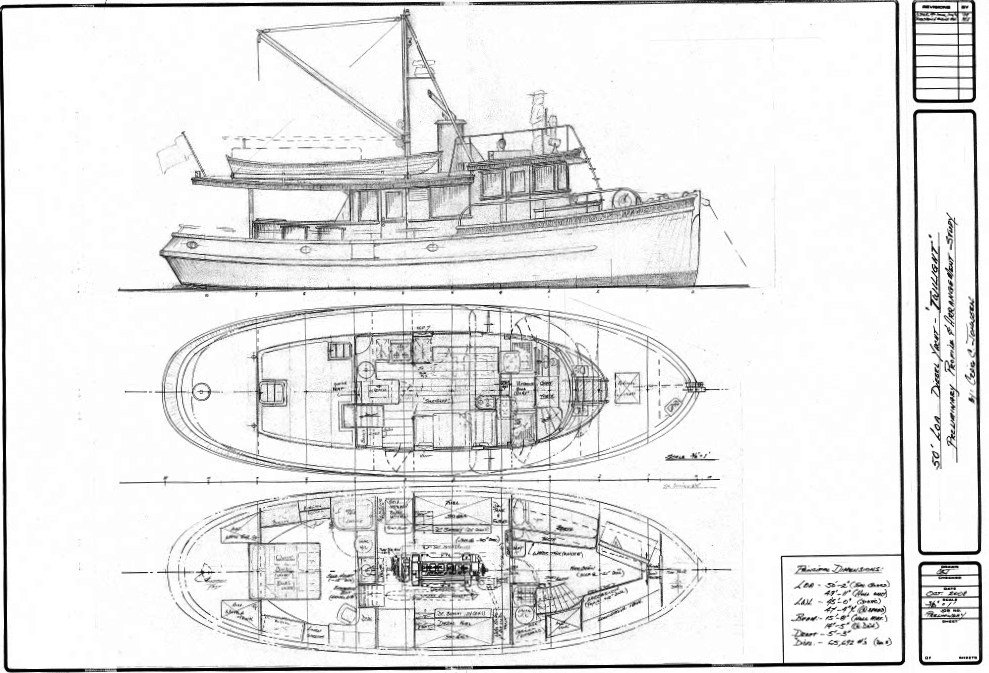
And, as often happens, life made changes to our plans and the drawings were shelved. The Gardner Diesel was sold to a good home.
When the model of MAGIC was completed, I was often asked, "Well, what are you going to build next?" Eventually last fall (and probably suggested by my better half), the idea of building a R/C POF model of TWILIGHT surfaced. The drawings of the preliminary design were resurrected along with the suggestions and design revision ideas we had entertained before that project "sank". A revised set of lines were drawn up to incorporate many of these thoughts. The wood racks were checked for suitable stock. I started drawing construction sections in January, 2024 and I will pick up the build then to bring the log up to date (May, 2024).
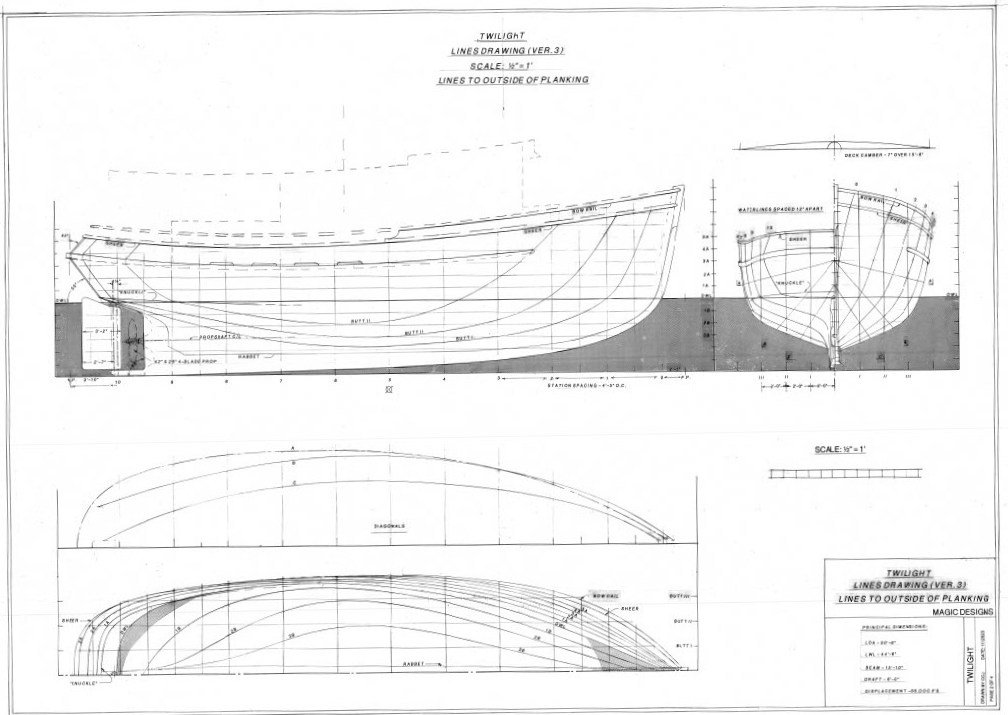
I hope that you will enjoy the process. I am inspired by the quality and work put into members' projects here and will strive to make TWILIGHT worthy.
-
Interesting indeed. I wonder about that schooner on the ledge, though. The bow of the Elizabeth Howard shows the long "spoon" bow of the time and yet, it appears from the photo that the stem in outline is considerably closer to a plumb bow. Did she get damaged in the bow and was later rebuilt? Or did the article mis-title the schooner on the ledge?
Just curious.
Craig
-
I am delighted to see your update, Steve. Yours is one of the builds that has that special attraction for me. Very nicely detailed.
Before we headed out to WESTPAC, we were issued a grey painted Boston Whaler with outboard to stow up on the boat deck. Handy for light duties but when it became necessary to send a crew back to secure a towline to a loose, ammo-loaded barge - as Typhoon Rose bore down on us - the bosun mates were glad to have one of the motor whaleboats to take them out and back as the seas were beginning to get ugly.
Craig
- Keith Black, Canute, Roger Pellett and 1 other
-
 4
4
-
This is one of my favorite stages in visualizing a new hull. Looking good!
- druxey and Mark Pearse
-
 2
2
-
Tim: Nice creative thinking to make it all come together so nicely! I will happily join the crowd following along on your build.
-
Fascinating work, Nils, and quite entertaining to follow along your construction sequence. I also will look forward to seeing how she comes together. 👏
Craig
- Mirabell61, FriedClams, Canute and 2 others
-
 5
5
-
21 hours ago, Jim Lad said:
That dinghy looks good, Craig. I'm afraid your model will never be truly complete until you add a model of Archie to join the other two crew members.
John
We are searching for a suitably sized cat figurine, John, because we agree with you.
- mtaylor, Mirabell61 and Jim Lad
-
 3
3
-
-
To deal with the somewhat ineffective rudder issue, we added crew aboard and to assist them, I created an additional rudder blade which bolts to the lower portion of MAGIC's scale rudder when needed for actual sailing times.
In the so-far not-very-effective effort to cut down the drag against the lazy sheets, both the mainmast's fore lower and foremast's intermediate shrouds were released from their respective turnbuckles and secured to bails on the forward faces of the masts. The correction of this tacking problem however still remains to be sorted out.
MAGIC, for accurate display purposes, needed additional deck hardware and rigging detailing.
Dorade cowls were made up from drilled out 1" diameter wooden balls and 1/2" brass tubing, then painted. The two after cowls also required sheet guards, which were fashioned from brass rod and small drilled plates.
A 2-speed-style windlass was created from carved yellow cedar, plywood and turned wooden gypsies.
The chain for the anchor was fed through a brass-lined opening in the bulwark, then over a newly-fashioned chain roller at the staysail tack band down
to a (painted wood) CQR hung below the bowsprit.Rigging enhancements included reef points and tackles, a topping lift for the main boom and a jib downhaul.
The crew needed a Shellback dinghy for shore liberty (and to transport the cat). This was built up from a 1-1/2" to 1' (1:8 scale) "kit" sold by the WoodenBoat Store, which consisted of a set of scaled down drawings, 2 sheets of carbon paper, a set of printed recommendations for a building sequence and various-sized pieces of pine and plywood. We painted it to match the original aboard MAGIC and lashed it down.
And this brings the construction blog up to date - July 2023. There will probably be a post or two more when I get her sailing smoothly. This post has perhaps exceeded the limit for photos, so I will start another reply with a final picture or two of MAGIC sailing on a local lake.
Craig
- GrandpaPhil, gsdpic and Valeriy V
-
 2
2
-
 1
1
-
18 hours ago, Bob Cleek said:
Beautiful photos! Quite a clever display solution, too!
If you don't mind a few curious questions:
How does she sail? Have you noticed any similarities in sailing characteristics between the prototype and the model?
How ded the R?C sheet servos work out? Is it possible to let the sheets run free in the event of a gust of wind and a potential knock-down?
I also am curious about retrieval options. She doesn't appear to be powered, so what do you do if she is becalmed or otherwise "incapacitated" in the middle of the pond? In the old days, when "free sailed" pond yachts were in vogue, they'd only sail them on purpose-built model sailing ponds and the boats that "went their own way" would eventually drift to the edge of the pond and be fetched with long poles or they'd have a row boat that they could use to go out and retrieve the model boats. As far as I know, there are only two such model yacht ponds in the U.S. anymore, one in New York's Central Park and the other, Spreckles Lake in San Francisco's Golden Gate Park. (See: https://www.sfmyc.org/ )
Bob (and others so interested) For a model, she seems to slip along nicely. She is reasonably quick in response to the transmitter's signals. The first sea trials indicated that additional rudder area would permit less rudder to need to be applied. Tacking was not crisp because both the headsail and the foresail lazy sheets were hanging up against the standing rigging. And, you know, after years of sailing the original MAGIC from the cockpit, changing headings was intuitive. Rudder control while standing ashore as the model sailed away was also not a mental stretch...but keeping it all together when she's heading back will take more training of the operator.
The jury is still out on the functionality of the sheet servos because of the lazy sheet issue. The servos seem to have the necessary torque but they do take time to tighten the sheets on the working side, however I'm not trying to make foiling-speed tacks. Not sure whether the sheets would release as fast as simple rudder action would let her up. More trials required there.
When she gets becalmed or "otherwise incapacitated" ( that expression got us chuckling, Bob), Vicky or someone else serving as "Rescue", paddles out to get her.
Here is Skip Allan serving as a reverse tugboat when the wind died the first morning. (Photo by Vicky Johnsen)
And Herself in WOODSTOCK. a Tom Hill ultralight glued lap canoe
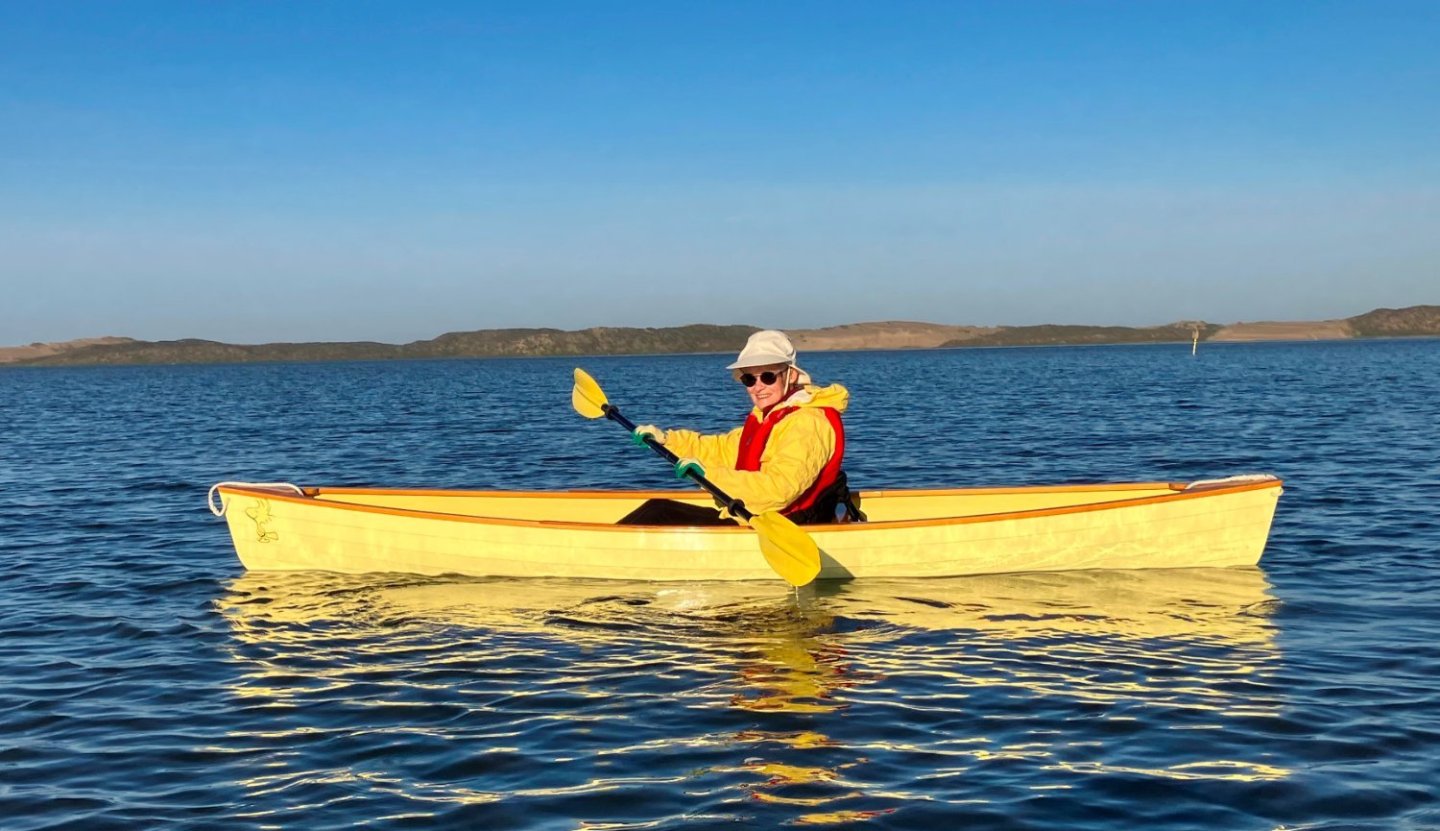
- Valeriy V, GrandpaPhil, mtaylor and 1 other
-
 4
4
-
It doesn't seem fair to leave this tale at the above picture.
We first launched MAGIC in late November, 2021 and managed some preliminary sea trials. These generated a bit of a "squawk" list, as might be expected and I managed to work on a couple of items before her next sail 2 months later.
Above image taken by Vicky Johnsen in early January, 2022
We were fortunate to be able to build a mounting/display cradle in the house to hold her before life intervened for 15 months. The only space with suitable height was above the fireplace (we have a cat - 'nuff said) but the supporting shelf needed to be able to be raised and lowered. Hollow-cored panels were glued up and bonded together and the hull rested along her centerline with a maple stub projecting up into the keel slot. A bolt projects from the backboard through the midship hawse of the bulwarks into a retention plate on the inboard side. This arrangement keeps the model from tipping over away from the wall. The mainmast clears the roof T&G by 3/8".
And here she sat, not quite finished nor properly sailing for the next 15 months or so.
Nearly current...
-
Sally soon stopped by with the newly-sewn up sails and I set to doing the necessary handwork at the corners, the sail slides and the fitting of the mainsail's battens. Once this work was done, I raised the new sails for the first time and began setting up the running rigging as well as tweaking the positioning and luff tensions on the masts.
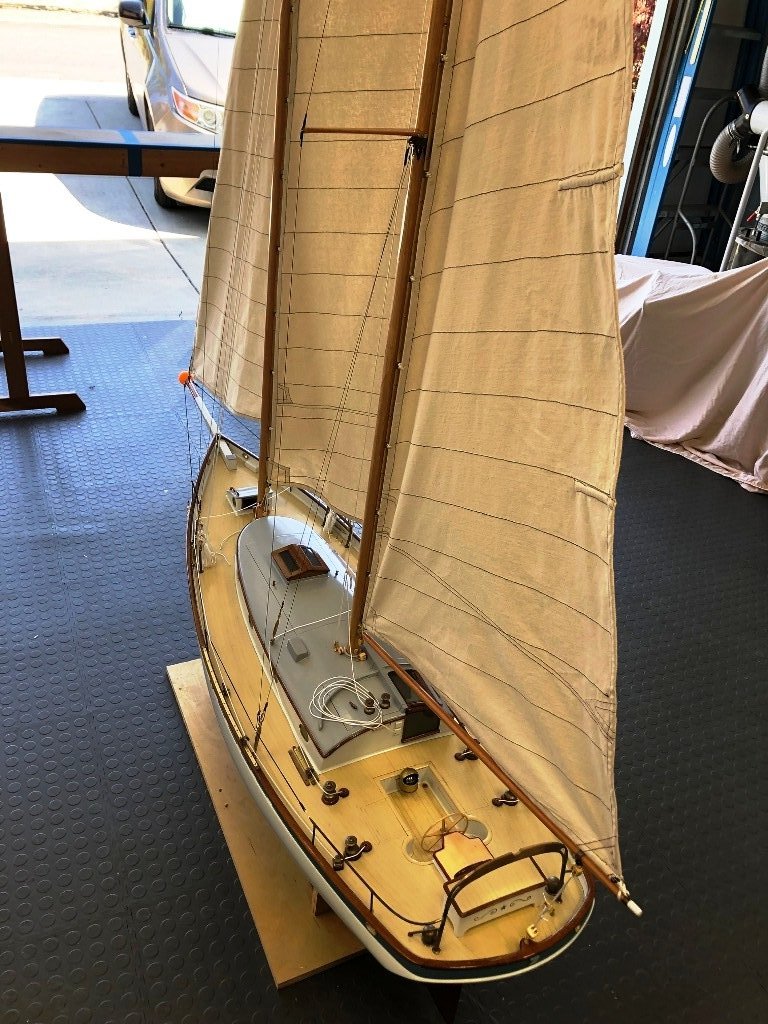
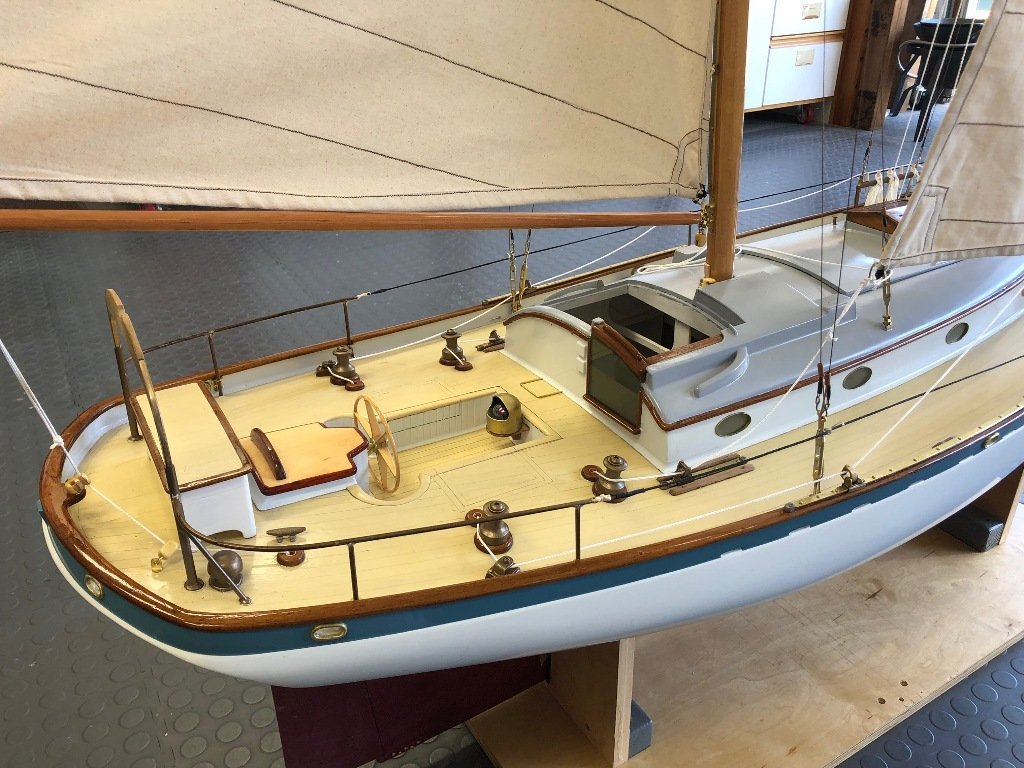
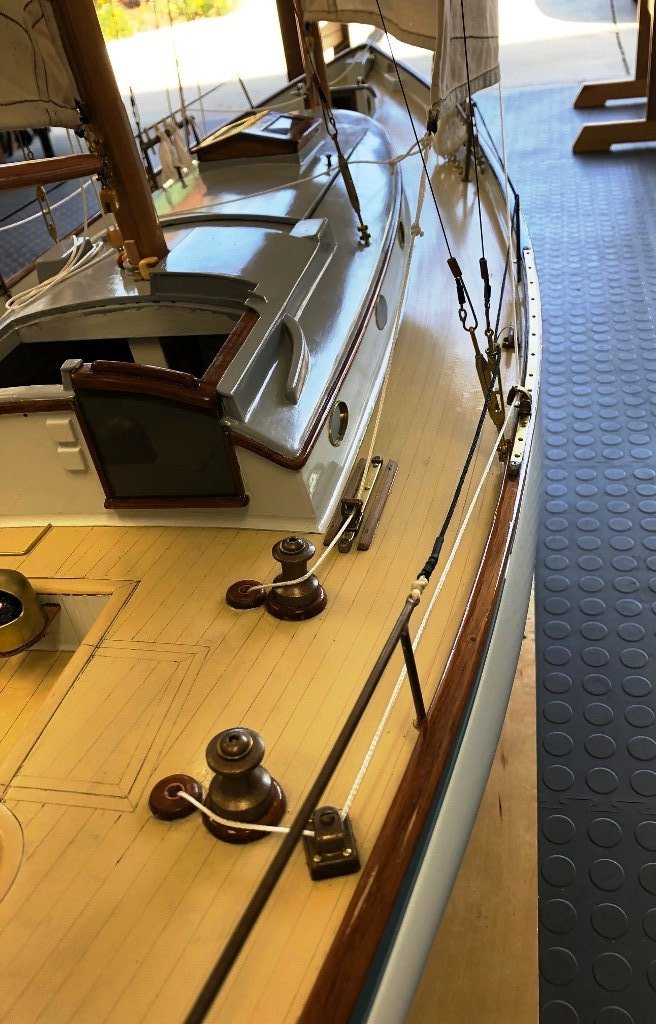
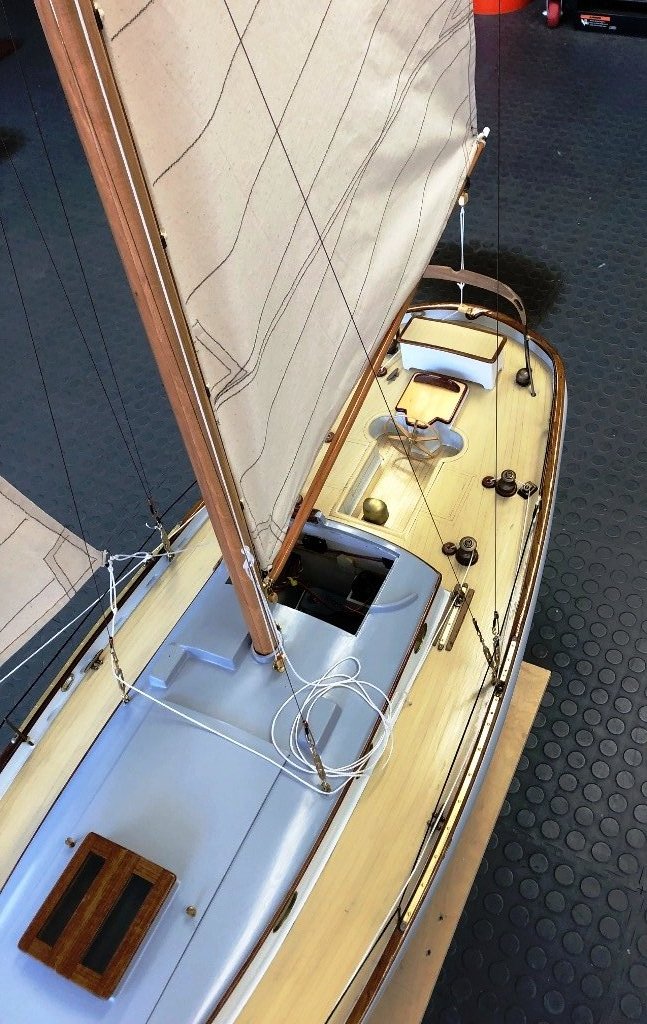
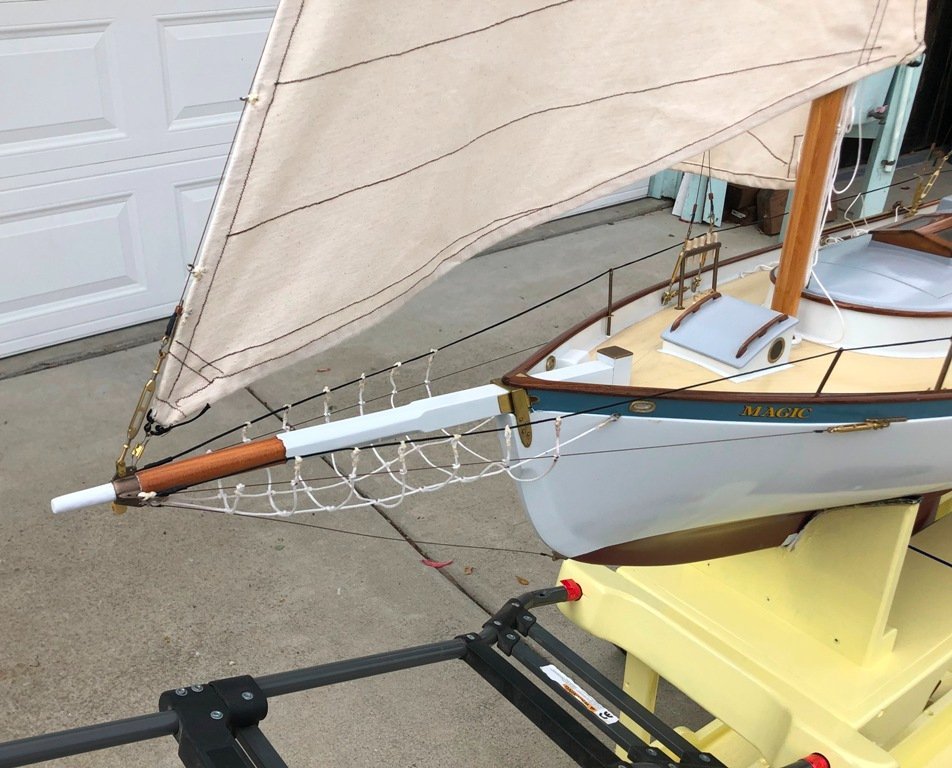
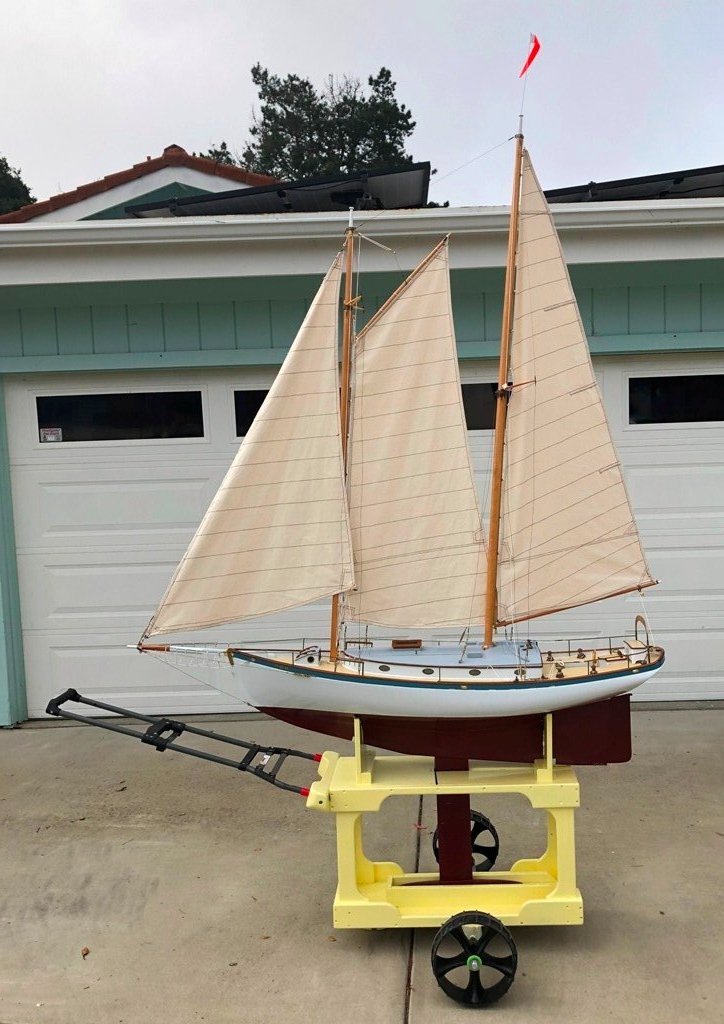
The bowsprit net was knotted up and hung in place.
And I started getting impatient to start MAGIC on her sea trails even though there remained a list of projects yet to finish. In our locale, there are very few useful launch ramps, either into a bay or nearby fresh water lakes. At that time, (November, 2021), we were also further limited due to the extreme drought's effect on the levels of the lakes. Since the useful access to the bay's two ramps was strongly effected by tidal height/current, there were also only a couple of days a month when, winds permitting, an initial launch for a sea trial made sense.
First launch and sea trials next
-
20 hours ago, Bob Cleek said:
Not sure if you are telling this story after the fact or in real time. I'm betting your local Joann's fabric store is going to give you a blank stare when you ask if they have any three-quarter ounce nylon spinnaker cloth!

Very creative fabrication solution for the sail track slides. They look great, too.
Bob: We are still catching up from the past, but getting closer. You are correct, of course, the young woman at Joann's would not have had any spinny cloth. However, she kindly helped me sort through the myriad choices available in weight and color to find the light tan (natural) duck that seemed suitable.
Thanks for the favorable mention on the sail slides. My soldering skills still need lots of improvement though. Next model will require a fair bit.
-
The masts were fitted with their respective mast bands, spreaders were made for both masts and MAGIC was again moved outside to permit stepping the masts. I used some black fishing twine as temporarily standing rigging and this permitted double checking the sweep and lengths of the spreaders. The spreaders were then strapped and glued to the masts.
The mainsail and the gaff foresail would use slides along their luffs, so tracks were fashioned from brass flat bar positioned on meranti "battens or feathers".
The sail slides were made up from hollow rectangular brass extrusions (which were a slip-fit around the brass flat bars). The extrusion lengths were placed in a tight-fitting groove cut in the bottom of a length of wood. The wood and extrusions were (carefully) passed over a partially-raised table-saw blade. This left a narrow open slot in the bottom of the rectangular brass which could accommodate sliding along the track-supporting feathers. The extrusion was cut into short lengths and bails of 1/16" dia. brass rod were bent up to be soldered to the aft faces of the slides for lacing on the sails.
Meanwhile, a neighbor (who quilts a lot) asked if she could help out: "Did I need any sewing done?" Why, as a matter of fact, I did! So we agreed that if I traced off some paper patterns of the sail shapes, she would whip up a trial set of sails from spare bedsheet cotton. It of course seemed like a good idea to double check the sails derived from the original drawings against the actual model's rig, so I crawled around on the shop floor for a couple of days making patterns and then turned them over to her. In very short order, this trial set of sails was sewn up and delivered.
This turned out to be a very necessary exercise before tackling the construction of the "final" suit of sails because there were several adjustments required to fit the spars and sheeting angles. Thankfully, we both enjoyed the process and Sally, the quilter, was eager to get on with the slightly heavier, revised sails. I made new revised patterns and off I went to a fabric store to find a more suitable cloth.
<More to follow another day.>
-
10 hours ago, Bob Cleek said:
Indeed they do. Actually, there are three basic types of molding sand and lots of specialty sands for various applications, but the basic, tried and true "el cheapo" material is called "green sand." It's a mixture of very fine sand with about ten percent finely ground up kitty litter and water. There are lots of YouTube videos on how to mix up your own casting sand. You can also buy it premixed from foundry supply houses.
Roger: What Bob said. I ended up reading mixed reviews about the kitty litter mixture so I used a pre-mix from a foundry supply house. This mix tamped down quite firmly and permitted the pattern to be extracted without the void which the pattern created crumbling excessively. Now, I do have a very heavy 3 gal paint bucket of the stuff sitting around, but I may need to cast a lead 6L3 Gardner diesel as ballast for the next model... 😉
- Roger Pellett and mtaylor
-
 2
2
-
I took the information from the float test and ascertained that the lead bulb for the keel should be close to or at 15 lbs. The next step was to determine how big the pattern would need to be to serve this purpose. I cut a piece of Western Red Cedar to a precise 2" x 3" x 12" size and weighed it on a digital scale. Calculations showed what the same size chunk of lead would weigh and the ratio between the two would permit me to whittle down my wooden design shape for the casting pattern until its weight times the ratio would equal the needed weight in lead. Once the shape would yield the correct weight, I was also able to create the necessary sized cope and drag "boxes" to hold the sand for the lead pour. After ramming the sand around the pattern and then removing the pattern, cutting vent and pouring sprues, we were ready to heat the lead and pour.
The result was decent enough to use and the center foil-shaped knock out was eventually convinced to exit.
I purchased a piece of aluminum plate (5/16" x 4" x 32") to use as the core for the keel bulb supporting fin and after some measurements were noted, I cut away portions of it to minimize the weight of the fin itself. The cutouts in the lower portion were filled with basswood, the fore and after edges of the plate were ground down to get rid of the rectangular shape, and then a couple of layers of the 3/32" thick plywood were laminated to the sides. The fin was shaped to a close approximation to a NACA foil, faired and then covered with fiberglass cloth set in epoxy. The tight-fitting bulb was bonded to the bulb with epoxy.
The combined weight of the boat and the keel would ultimately be 41 lbs. and I realized that some form of a launch cart was going to be necessary to avoid serious back issues picking her up or putting her in. With the keel now able to be put in place, a launching cart design came together (somewhat inelegantly) from odds and ends in the shop. An extendable baggage cart handle was added later to avoid reaching under the bowsprit. The hull, with its keel, was intended to slide aft off of the submerged cradle, with the keel fin slipping through the upper slot of the cart. (Note to self: wooden carts may float which is not always useful.)
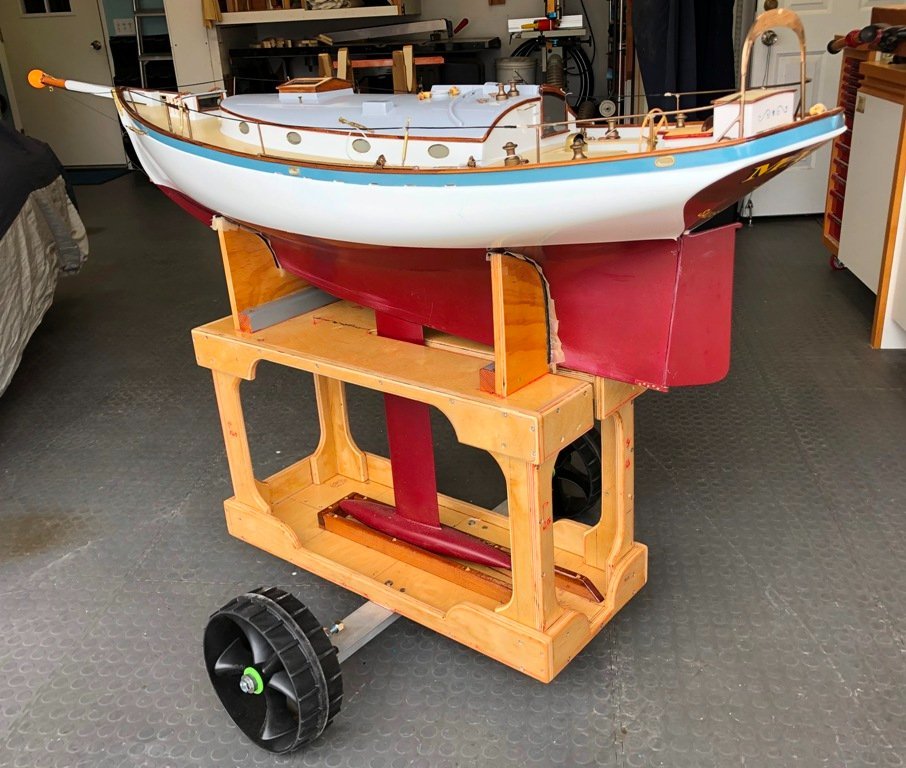
Rigging and sails were next.
- Roger Pellett, mtaylor, GrandpaPhil and 1 other
-
 4
4
-
1 hour ago, Jim Lad said:
An absolute delight, Craig.
John
Thank you, John for the kind words. I am delighted that you and others are enjoying the build blog. The expertise in these forums is an inspiration (and humbling). I am delighted that Bob Cleek posted a link to Michael Mott's project some years ago because Michael (and several others) set fine standards for quality and precision.
-
To finish up today's posting, I will add some photos of hardware installation. The boom gooseneck (and later, the gaff car) came from a retired USCG man living in Florida who was manufacturing brass sailing hardware. The rest of the hardware, such as the pinrails, stanchions, sway hooks, tracks and sail cars were efforts on my part. (I certainly hope to acquire a small lathe prior to the next model...)
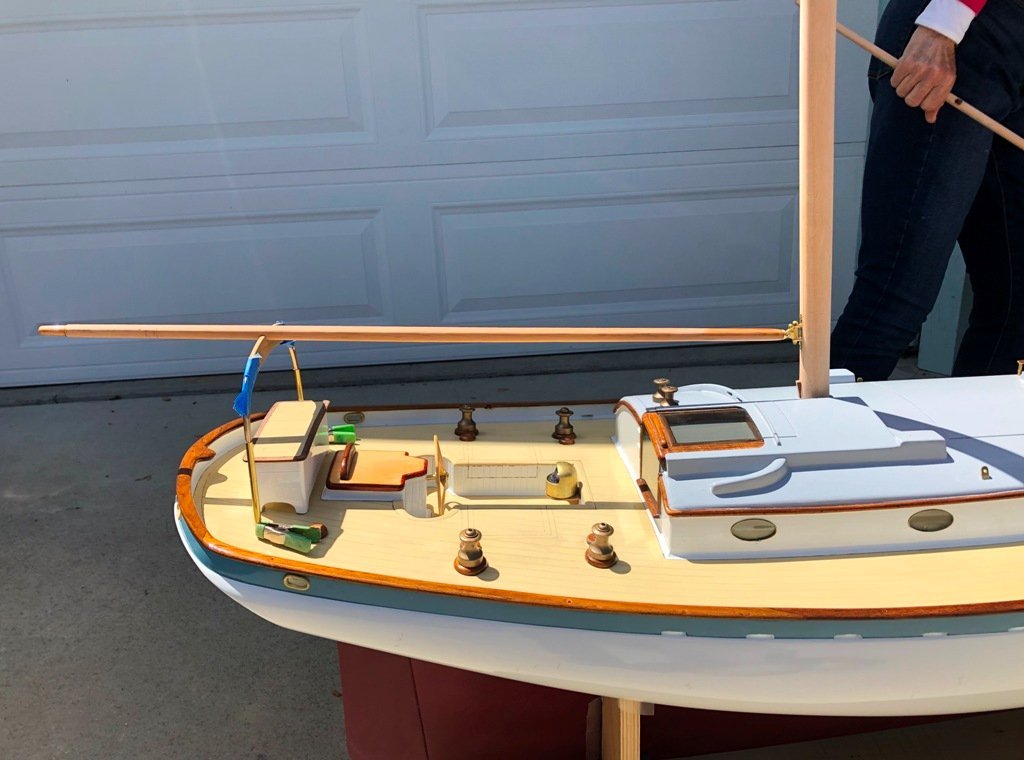

I used a drop of CA glue on a brass strip to hold the #2 nuts in alignment while tightening the turnbuckle mounting bolts. I confess to a fair amount of frustrated swearing during this exercise in patience.
Until again.
- GrandpaPhil, Valeriy V and mtaylor
-
 1
1
-
 2
2

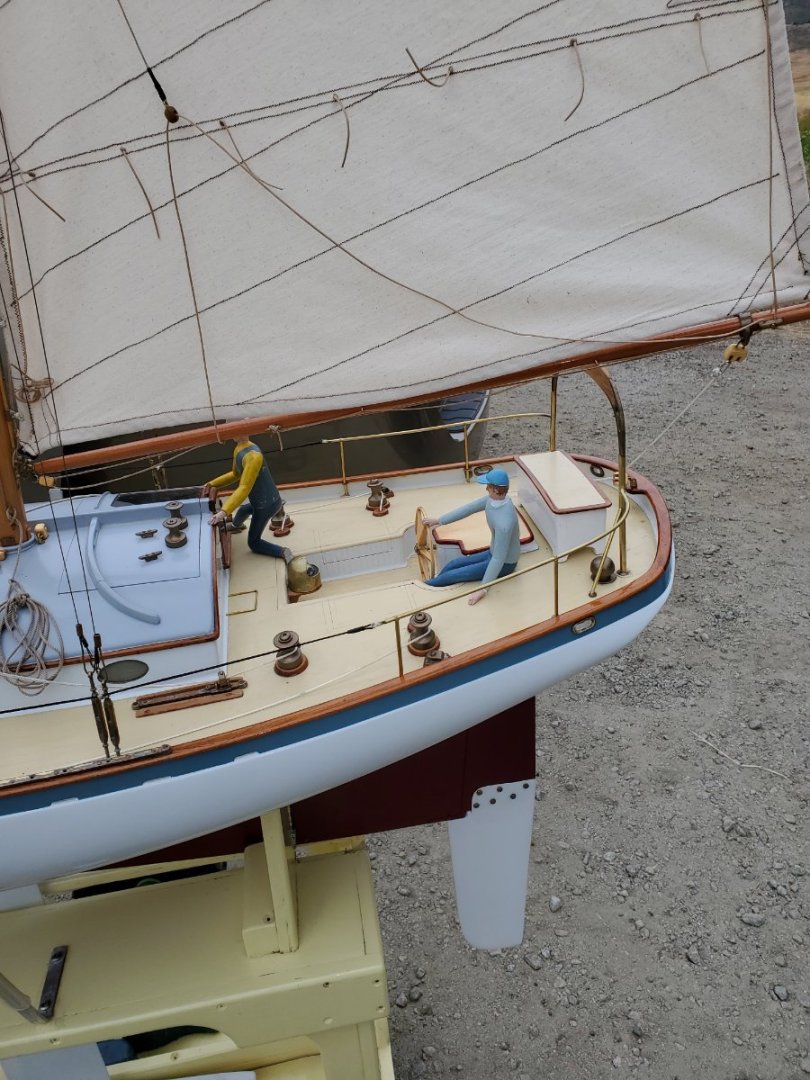
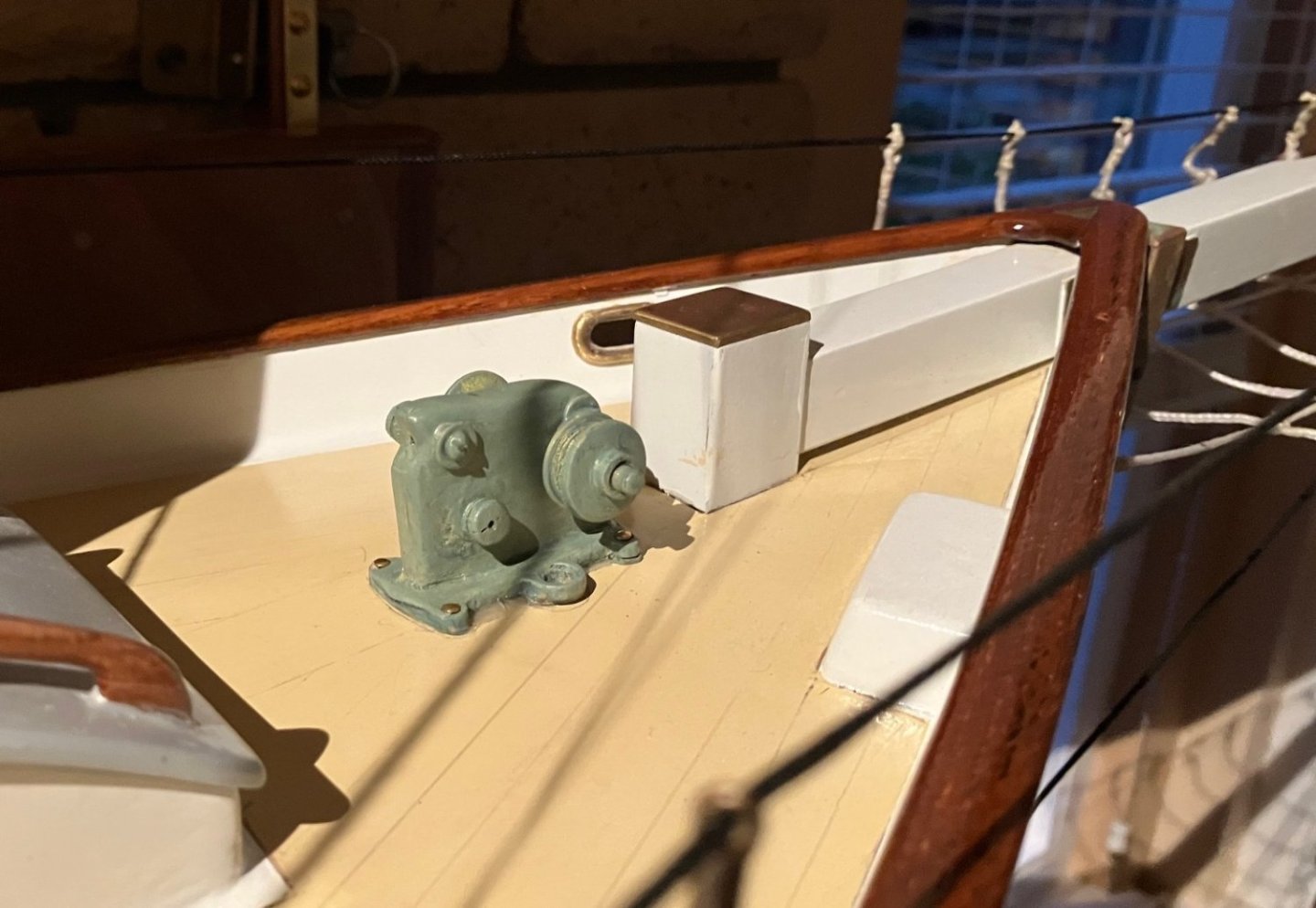
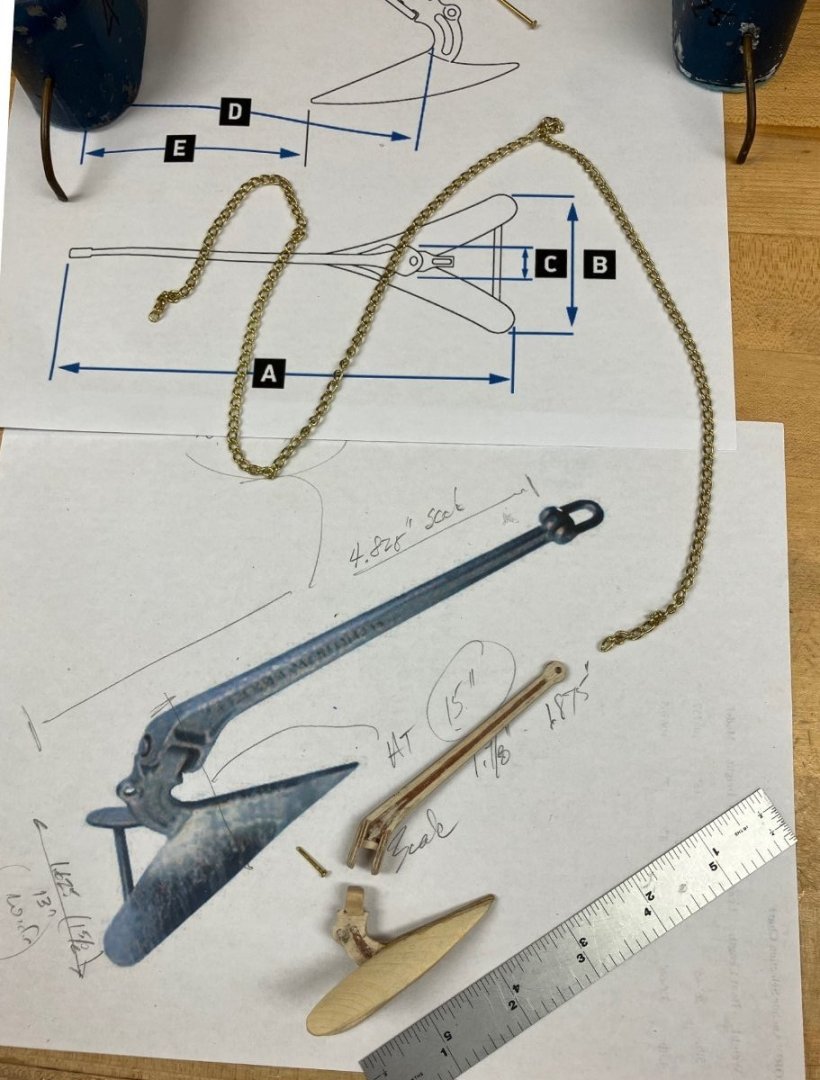
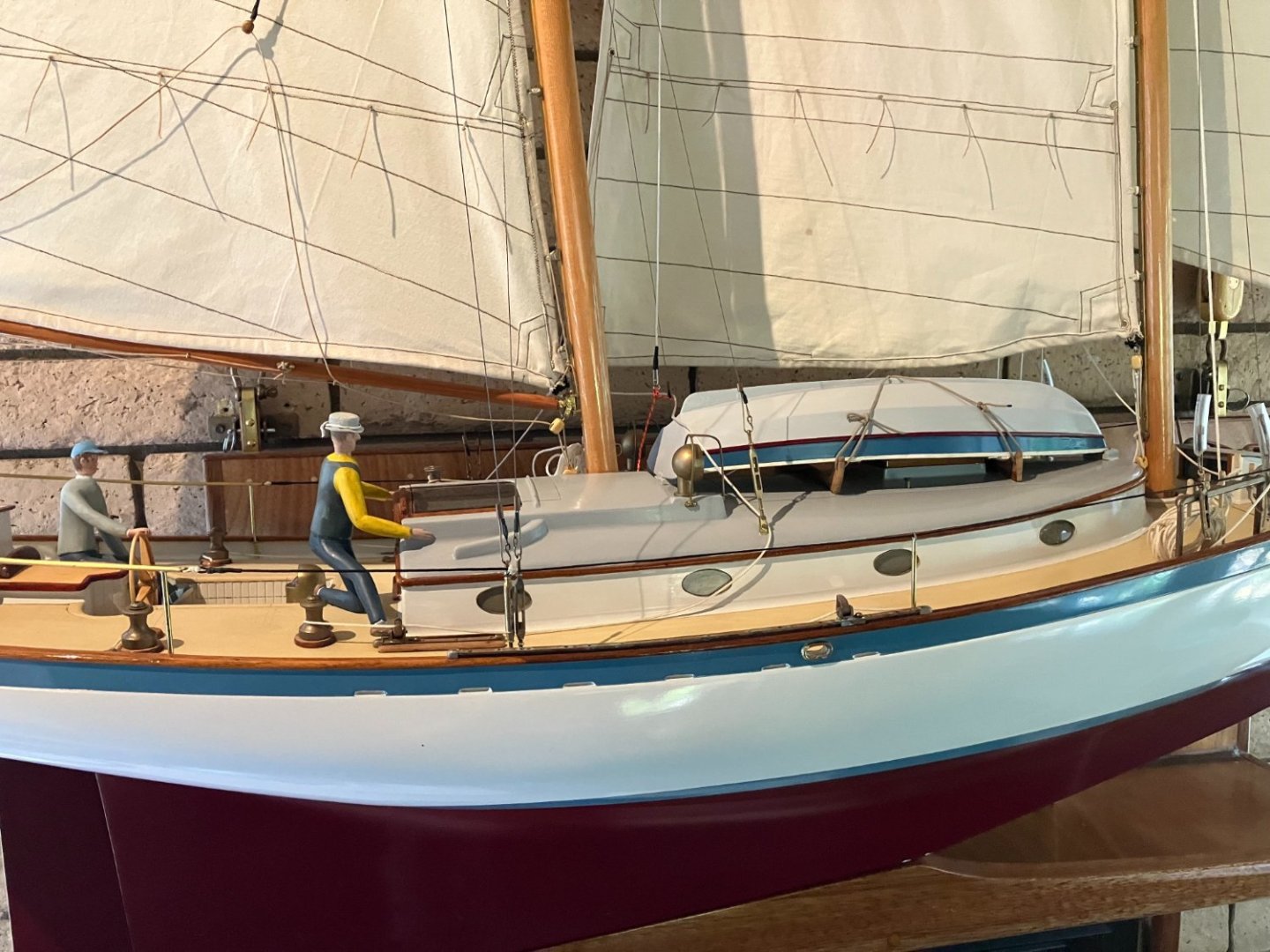
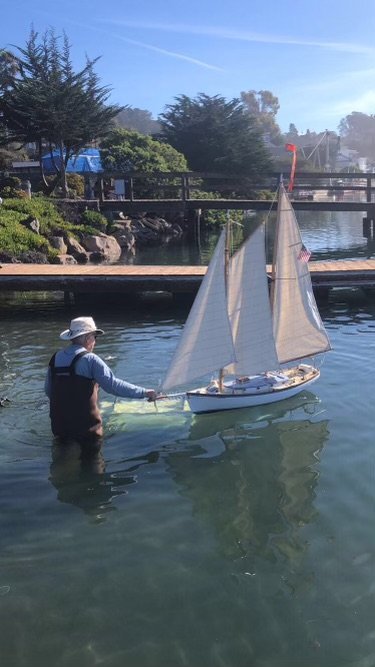
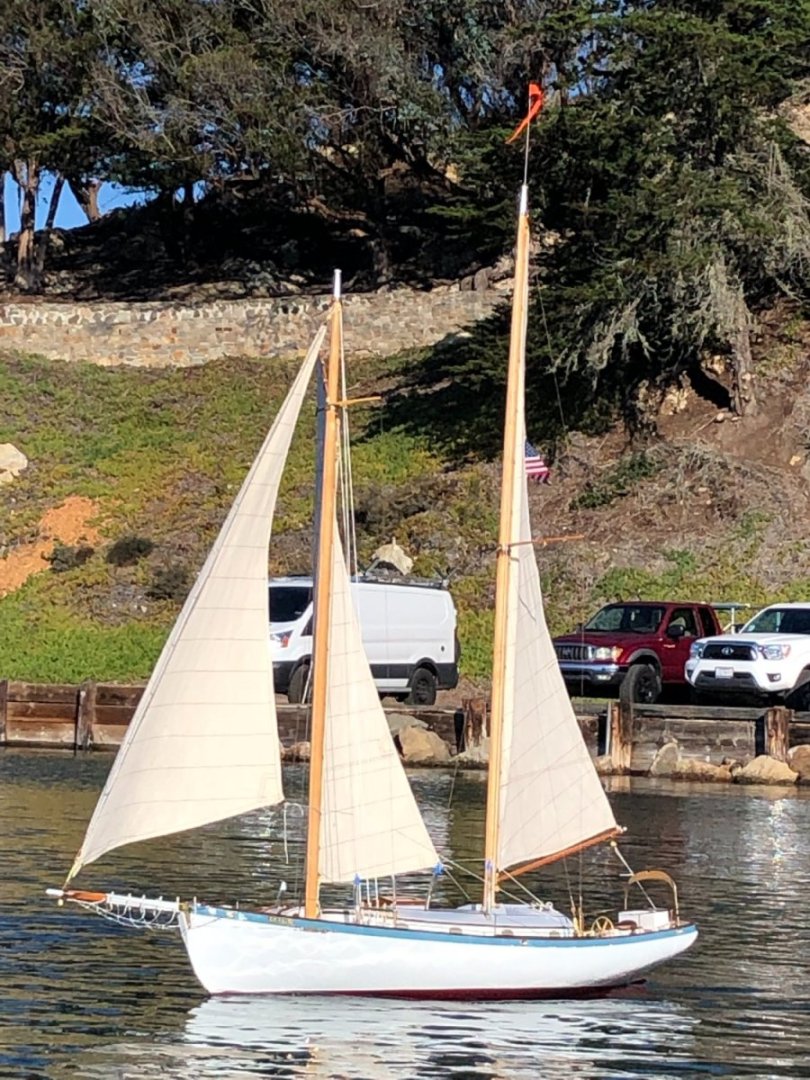
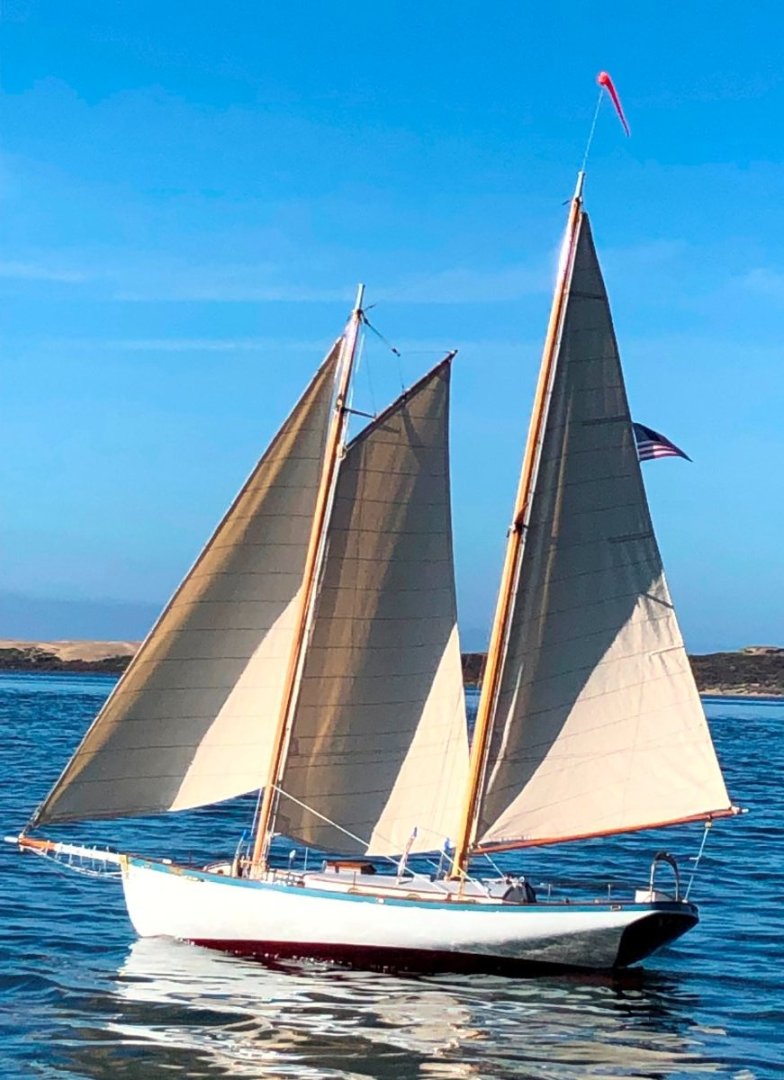
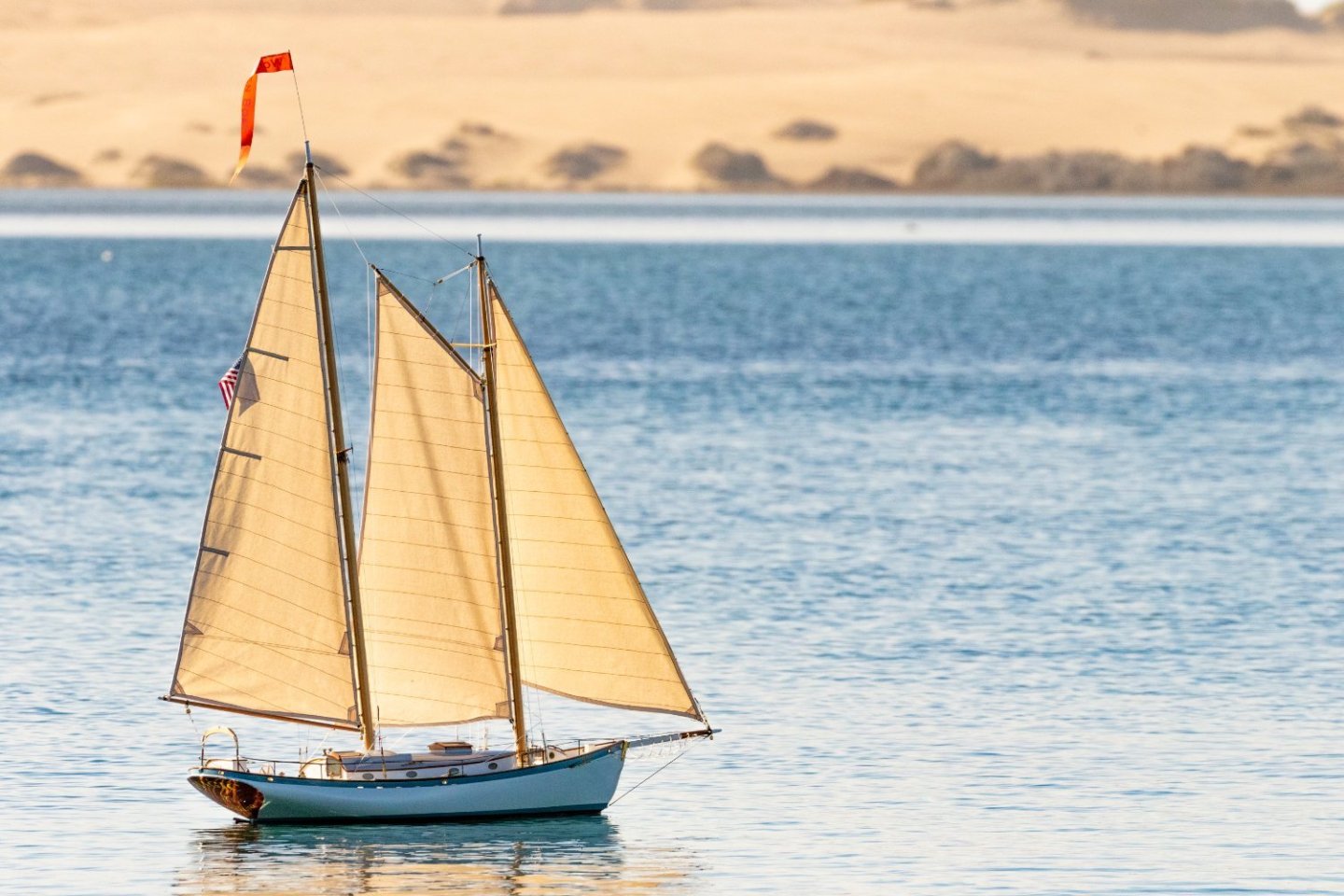
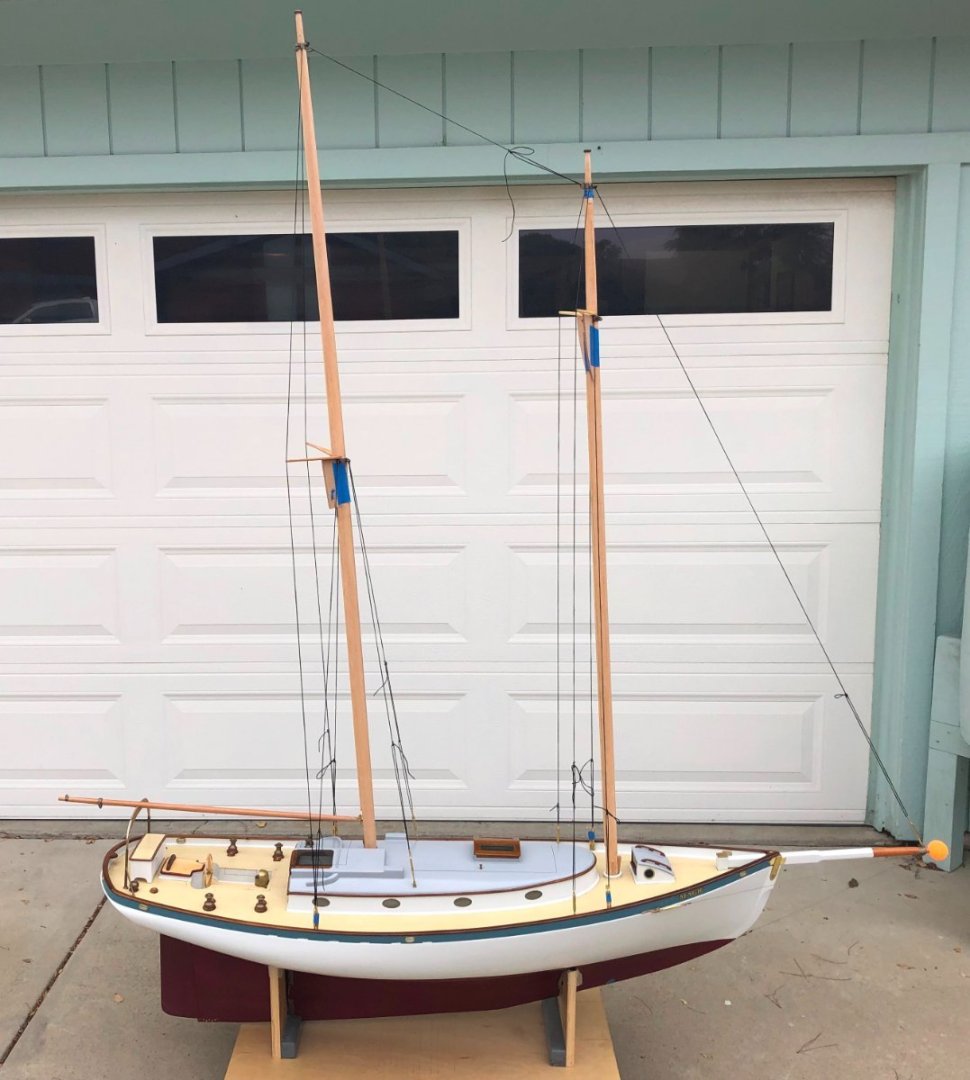

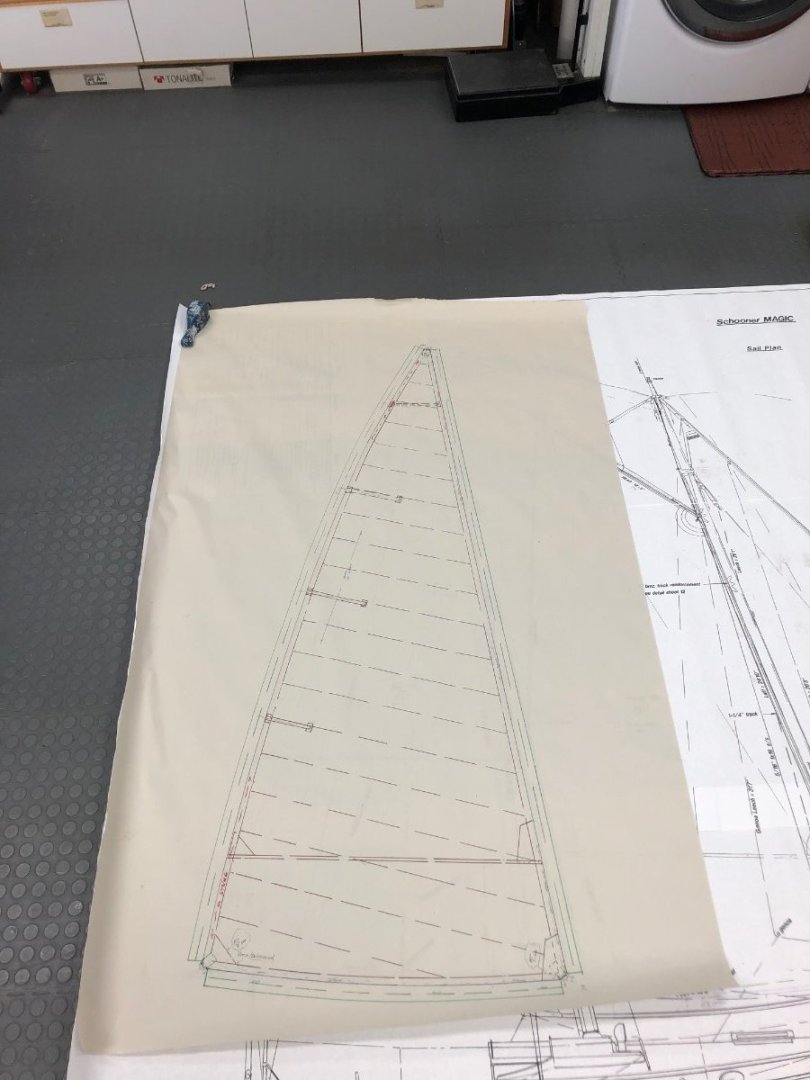
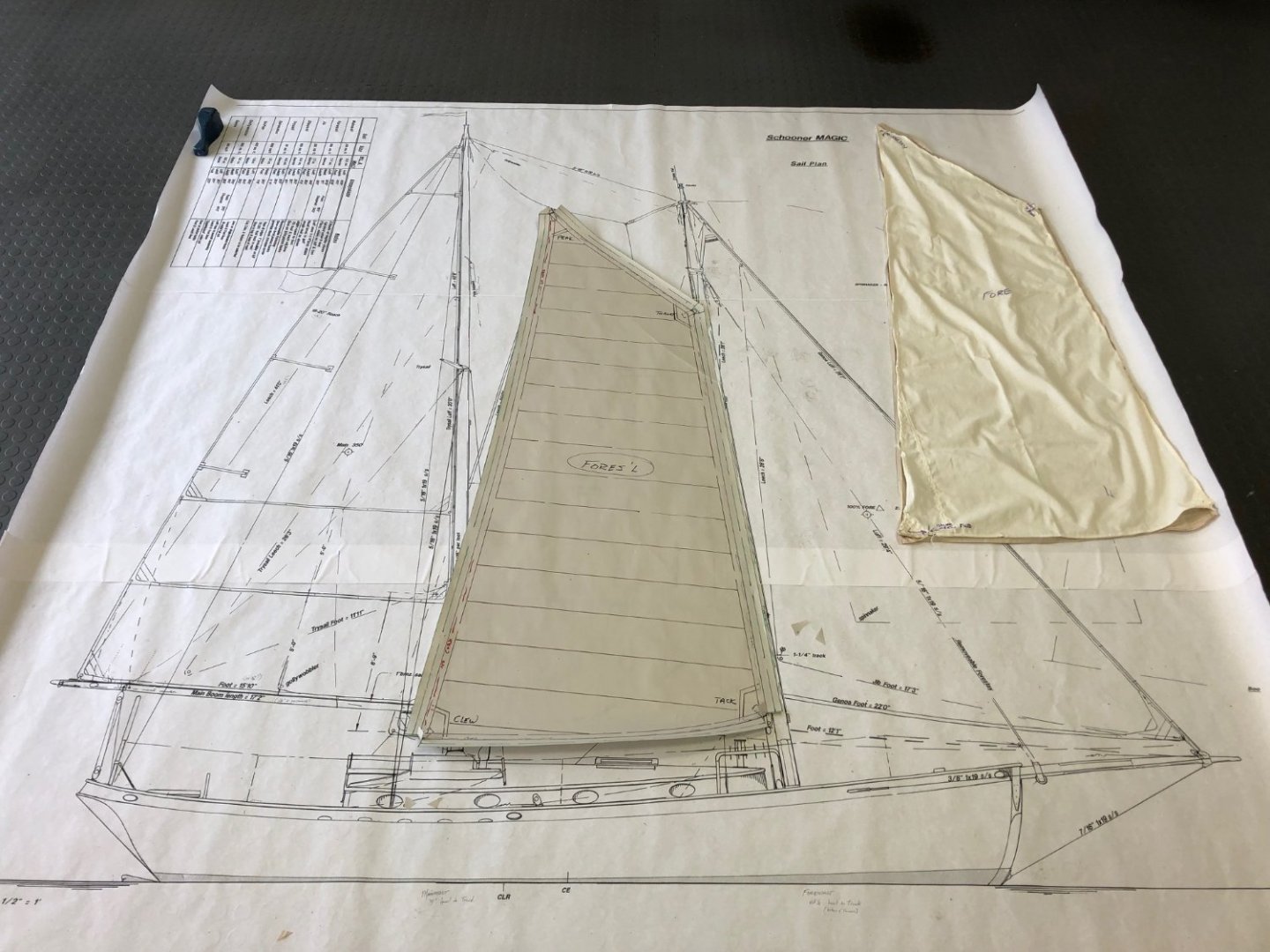
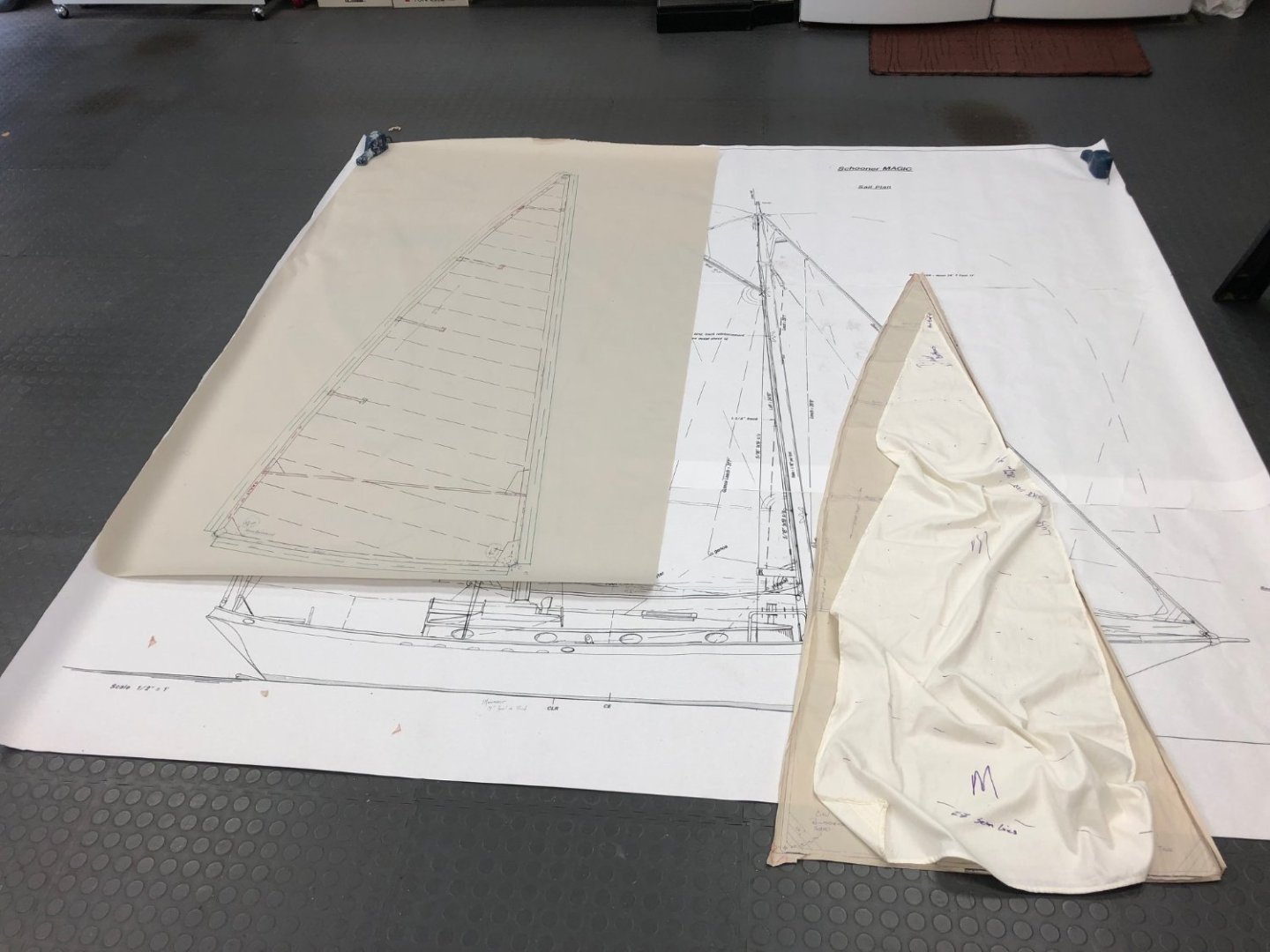
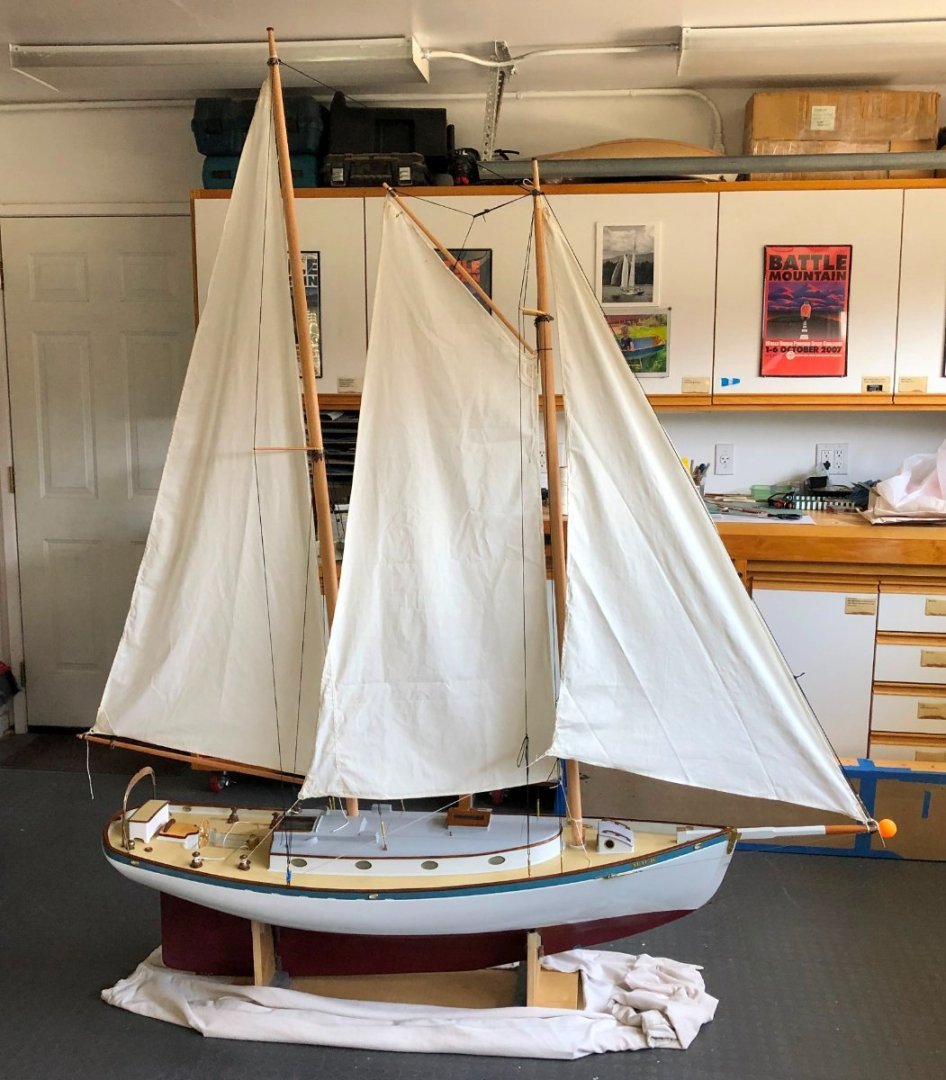
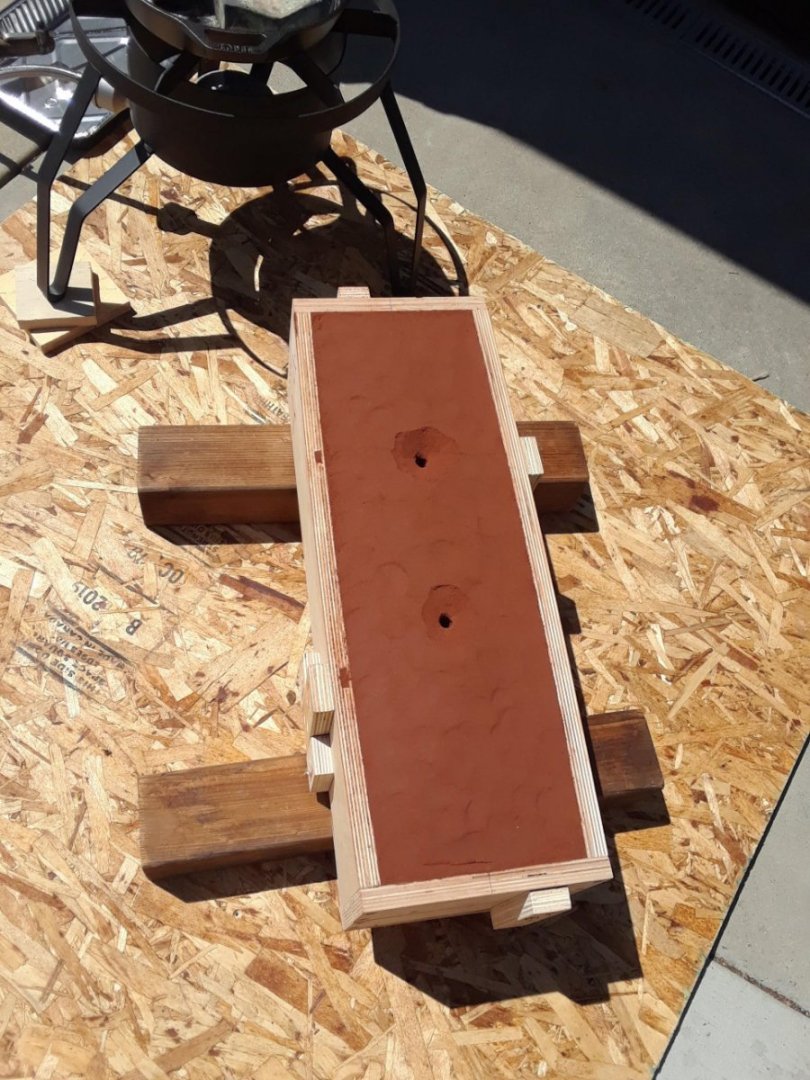
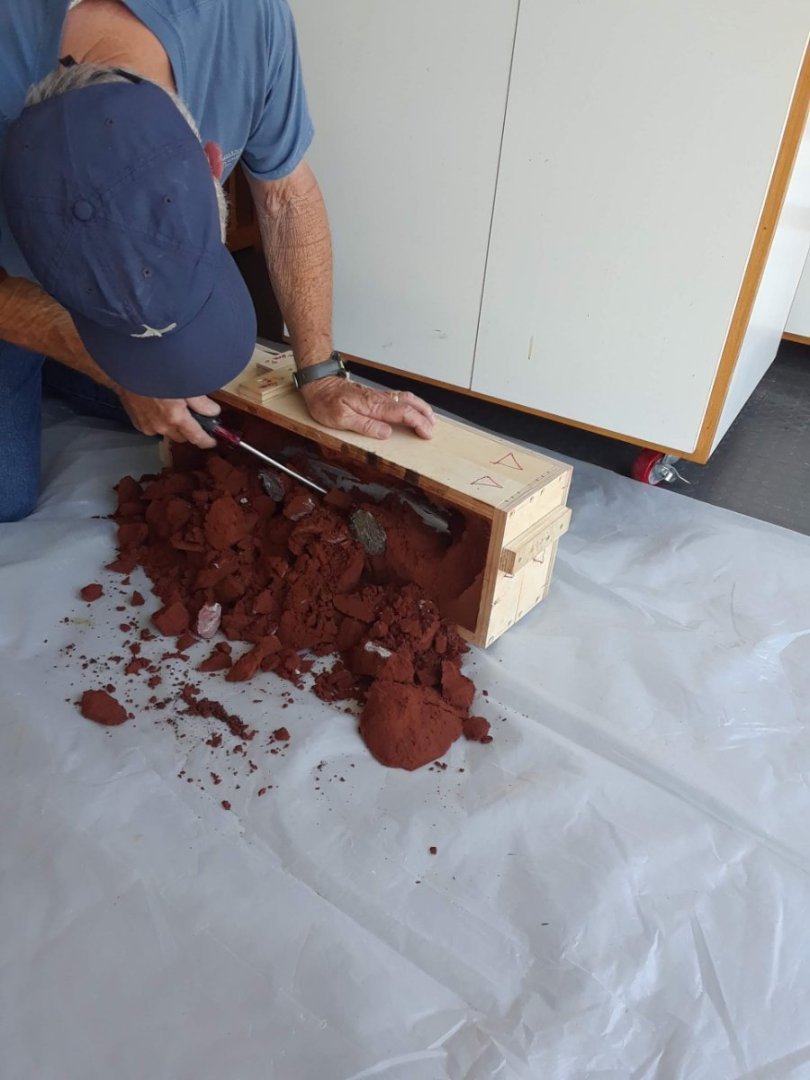
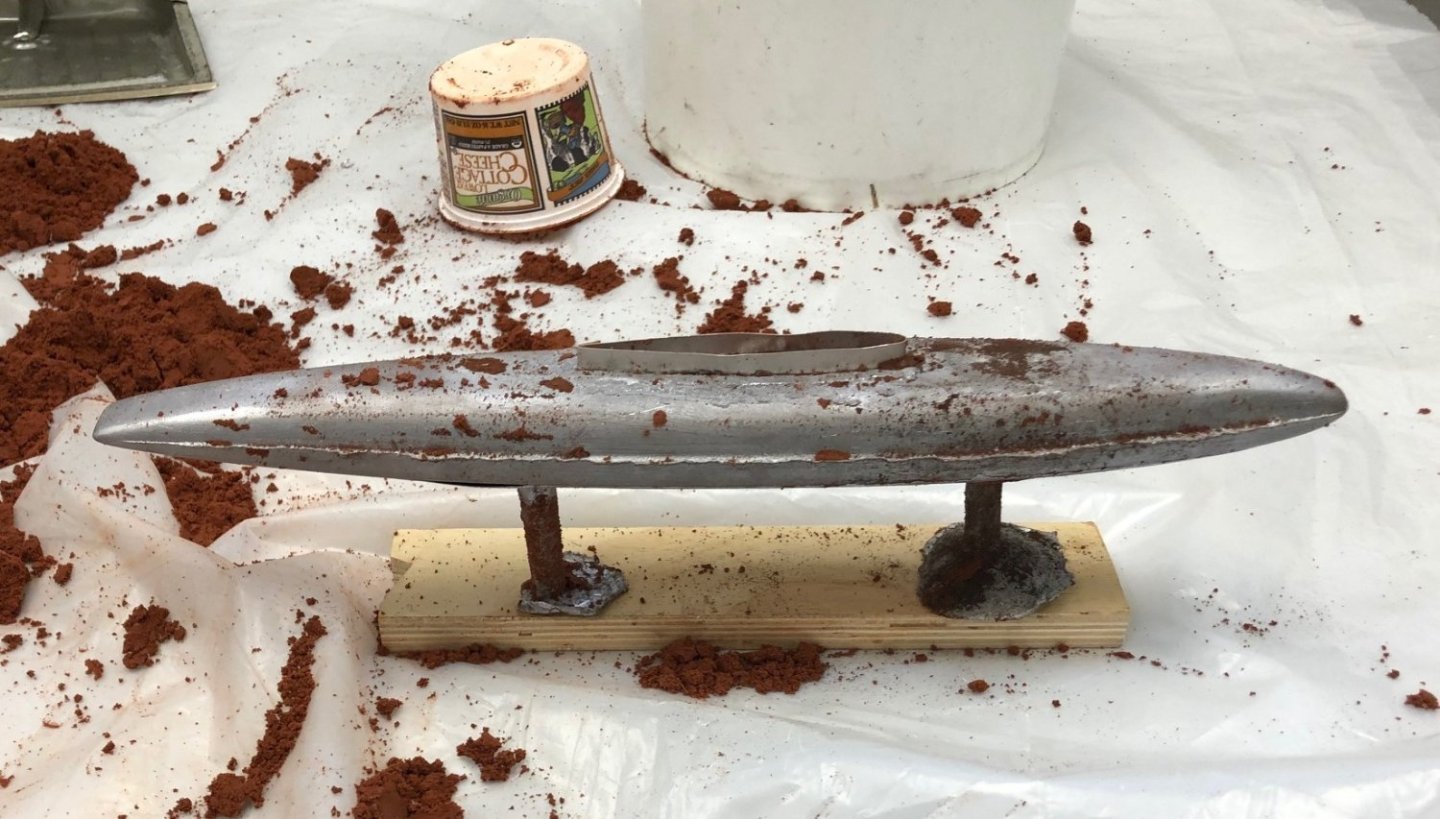
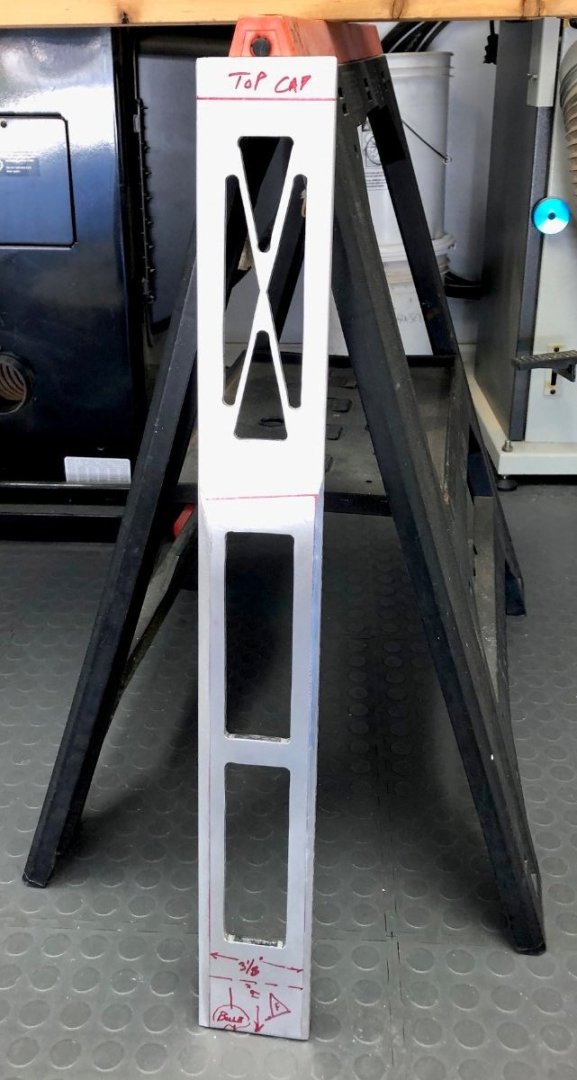
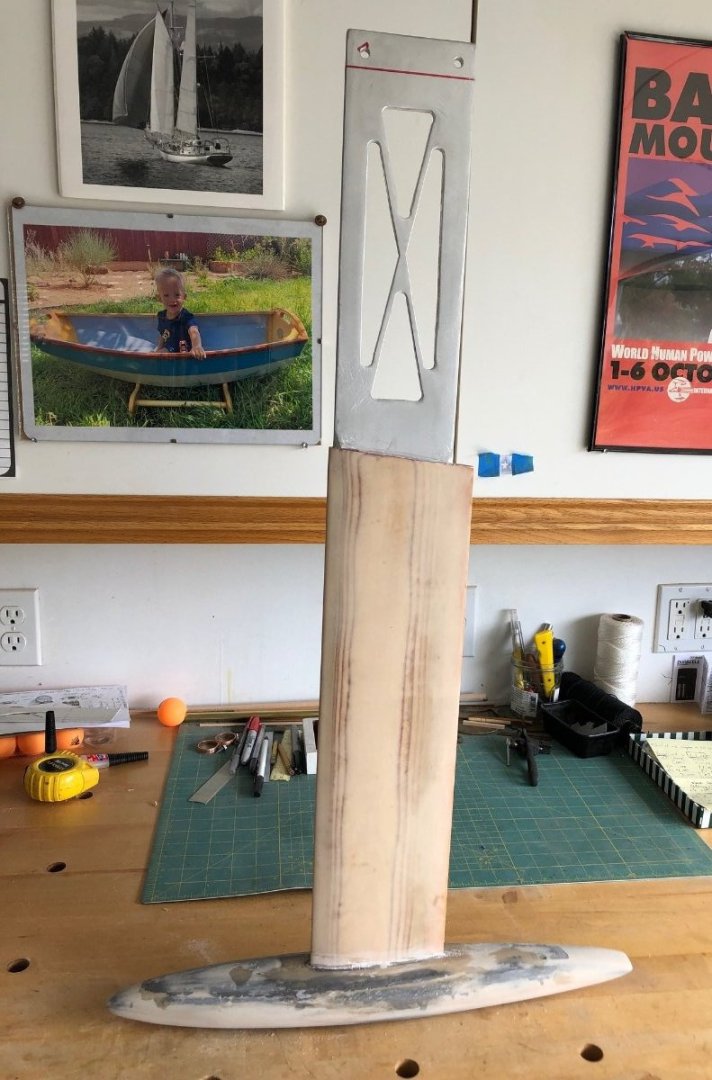
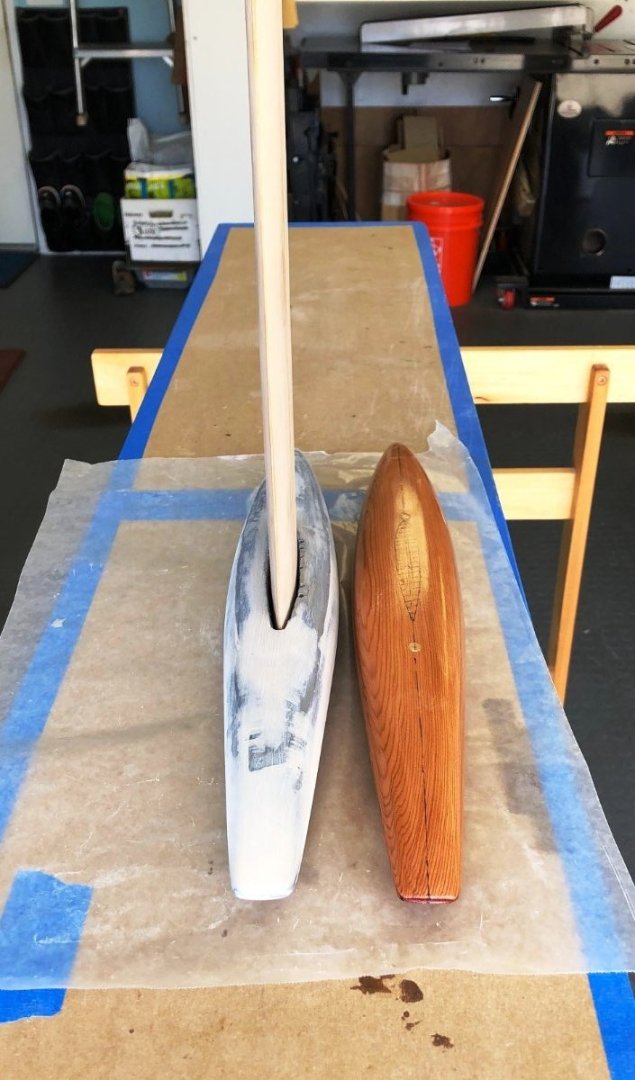
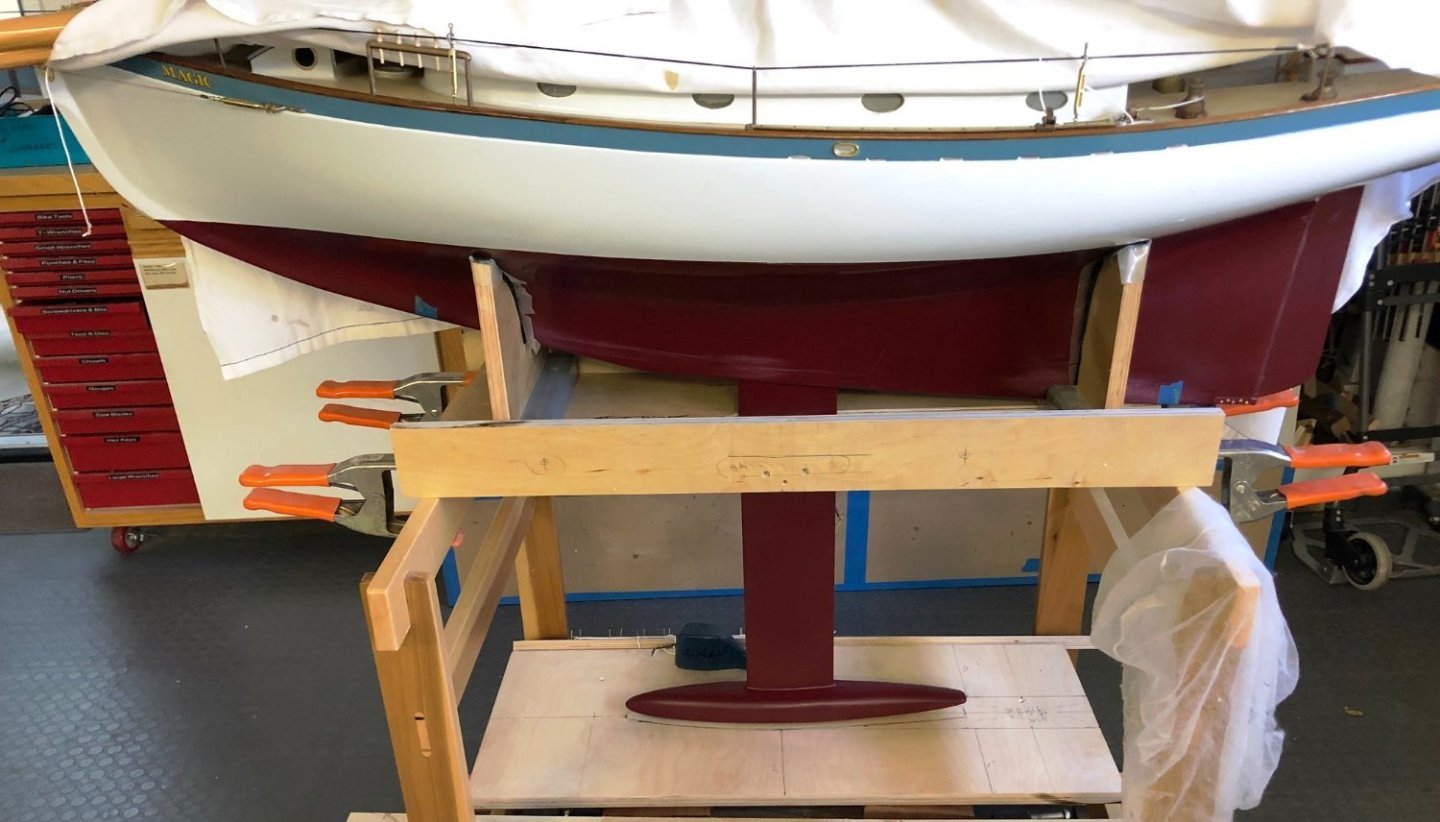
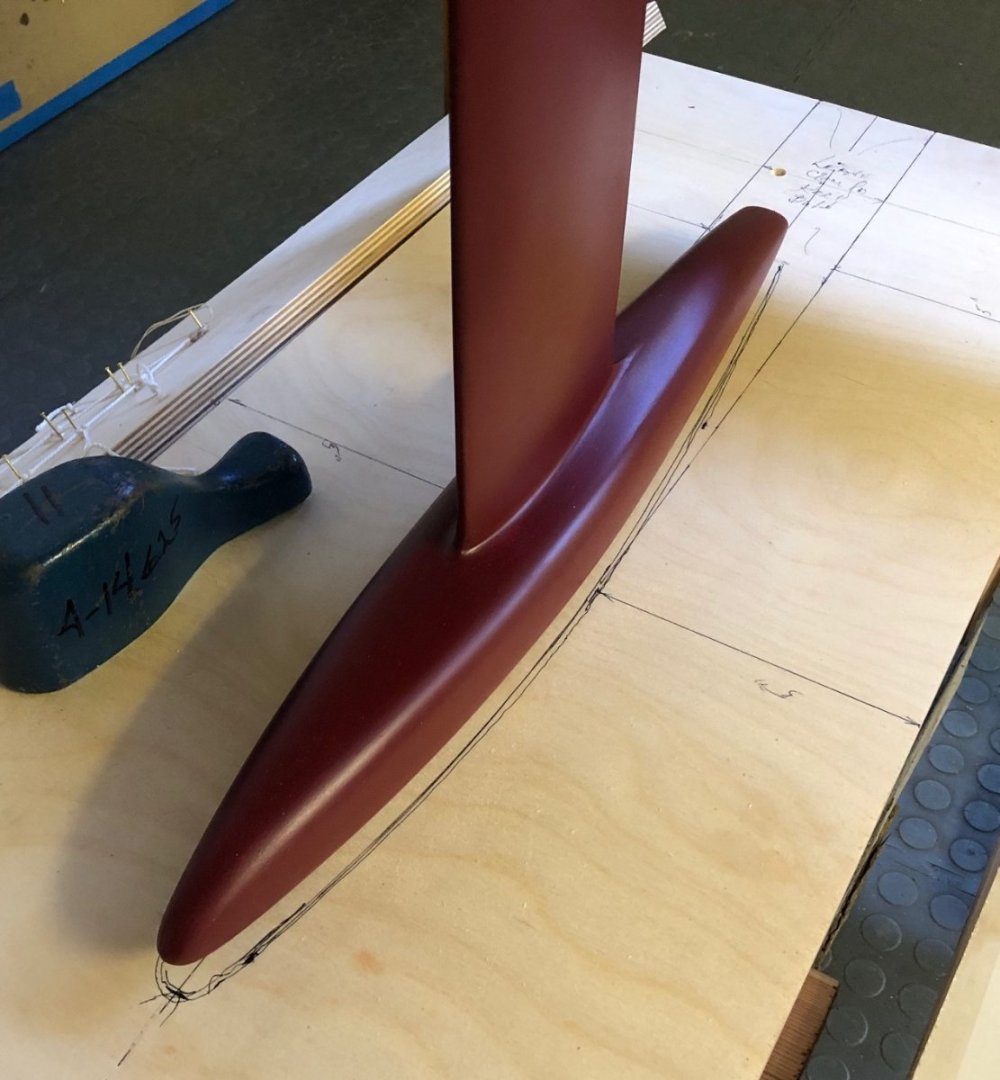
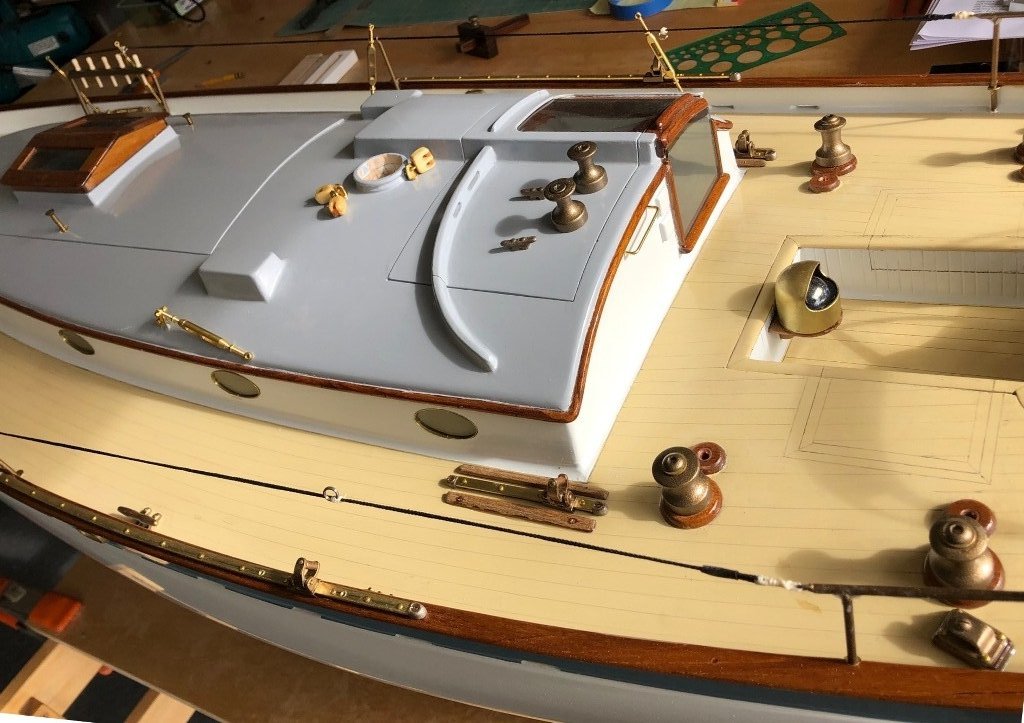
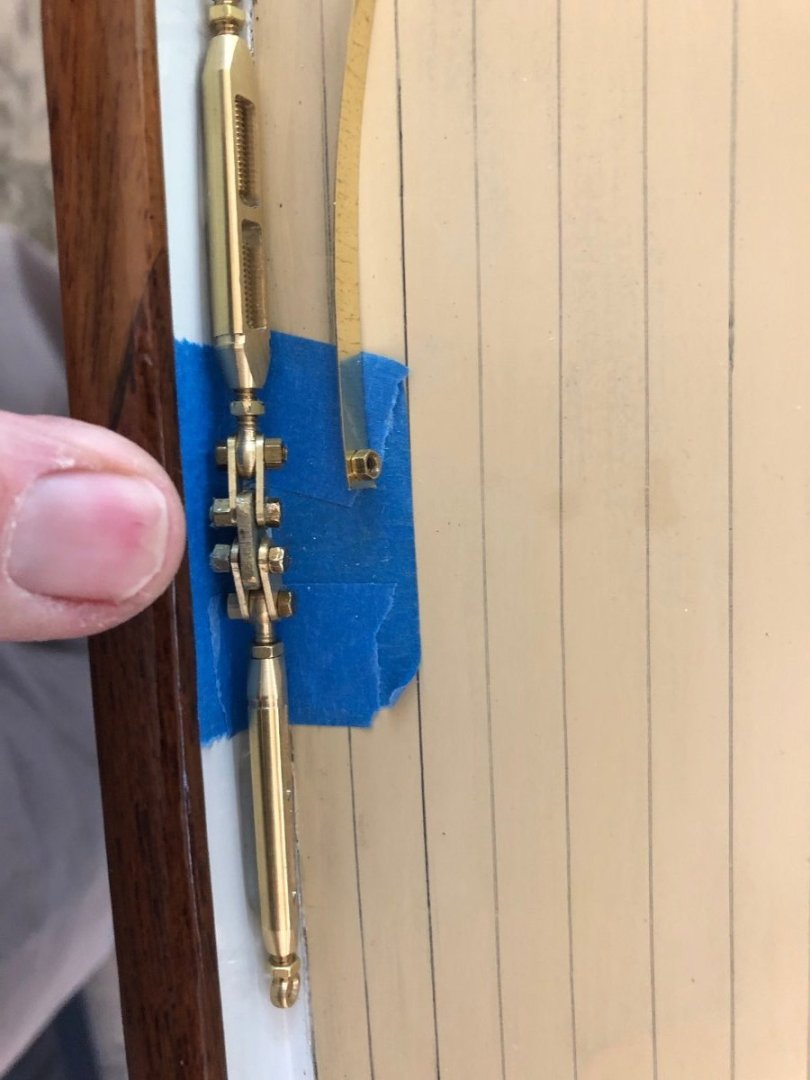
TWILIGHT 2007-2009 by MAGIC's Craig - Scale 1:16 - RADIO - Pacific Northwest cruising powerboat
in - Build logs for subjects built 1901 - Present Day
Posted
For the rudder, I borrowed ideas/techniques from Ken Foran's excellent Model building with Brass as well as Cangarda 1901 by KeithAug . The rudder post is 1/4" dia. brass and the through-soldered fore-and-aft supports are 1/8" dia. brass. The notched-out core portions of the rudder are Alaska Yellow Cedar and the cheeks, laminated to each side, are made from 3/32" baltic ply. A card template was used for reference.
The cheeks had recesses carved in them to accommodate part of the diameter of the rudder post to keep the rudder assembly from being too fat. The various layers were epoxied together.
The shaping of the rudders foil was a process of filing/sanding the cheeks and core , evenly exposing the parallel glue lines of the ply until a satisfactory shape was achieved.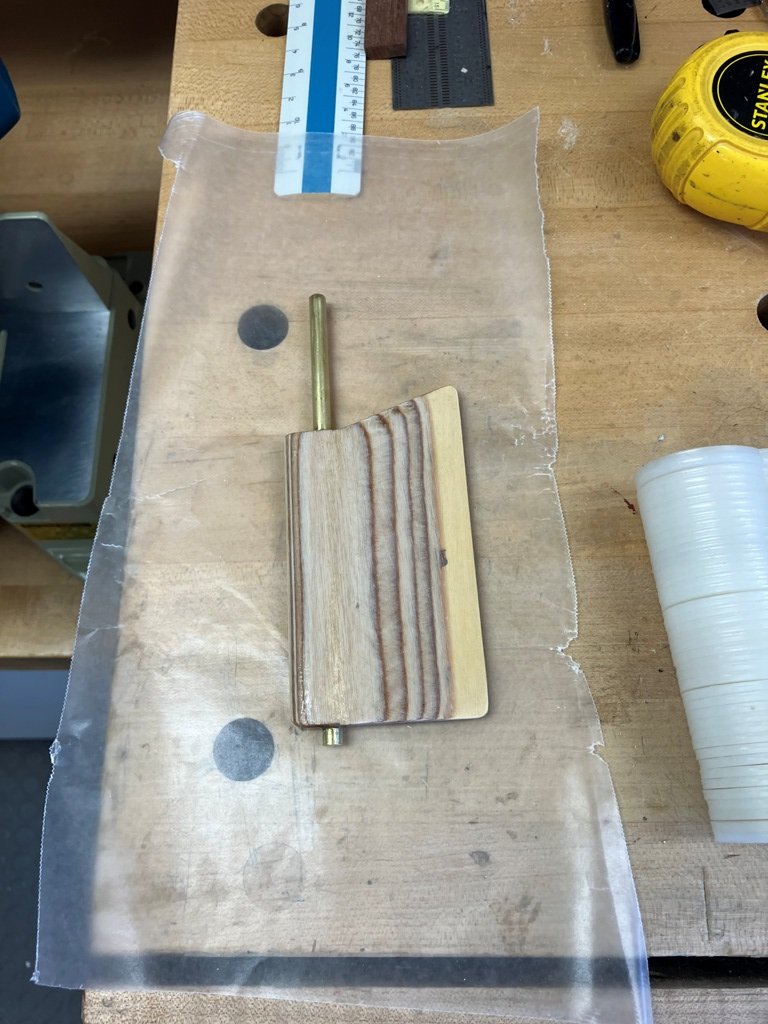
A removeable brass lower gudgeon was soldered up to accommodate the lower rudder bearing at the correct distance aft of the sternpost.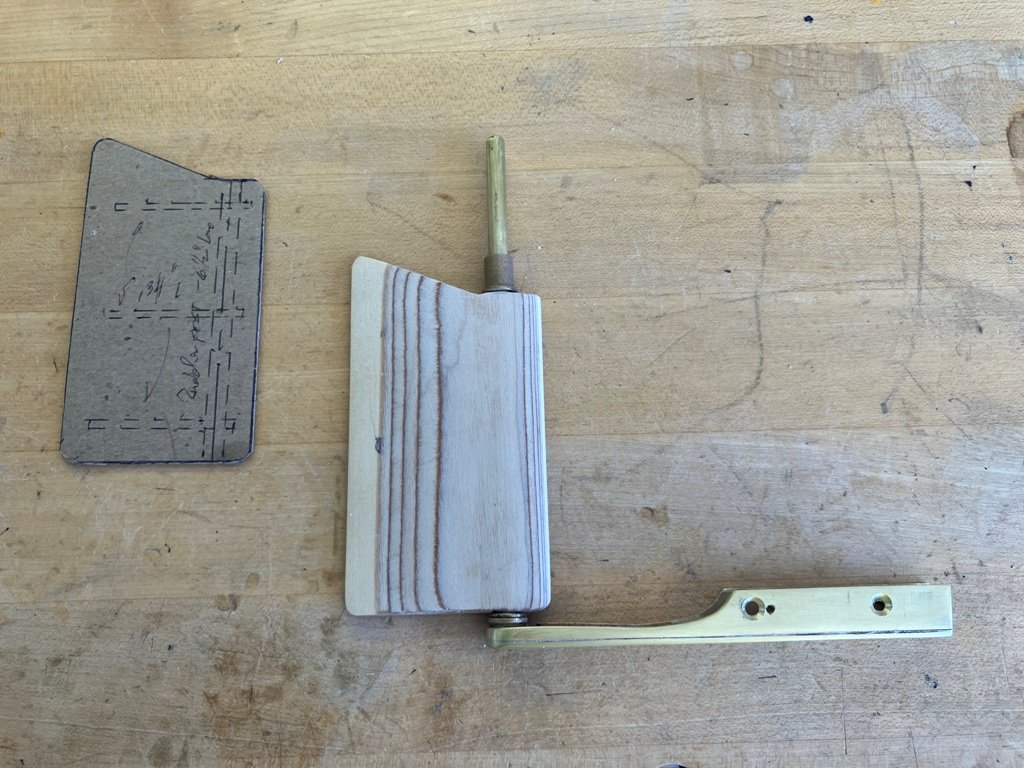
It was then epoxy-sealed and (temporarily) fastened in place.
And with that, we are current with the build (as of Mother's Day, 2024)